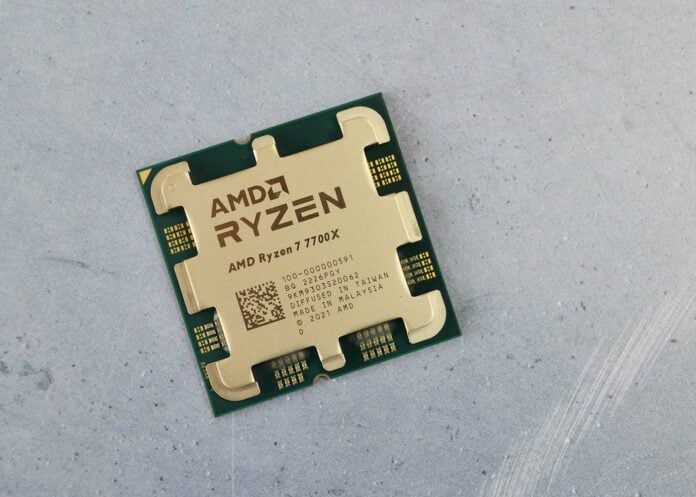Zen 4 has arrived. After months of hype and years of anticipation, AMD’s latest and greatest desktop CPUs take the form of four high-end chips on an all-new AM5 platform. Ryzen 9 7950X (£740), Ryzen 9 7900X (£580), Ryzen 7 7700X (£420) and Ryzen 5 7600X (£320) are destined to draw the attention of enthusiasts across the land, and there’s cause for celebration among AMD fans; this is a company that has rediscovered its mojo.
Fortunes change quickly in our industry. Seems only yesterday AMD was struggling to deliver competitive products under the FX umbrella. The likes of Bulldozer and Piledriver have faded into memory, and credit where it’s due, AMD bet big on a chiplet architecture that would revolutionise the company’s future in more ways than one. Ryzen was born just five years ago, and the Zen microarchitecture has gone from strength to strength with each subsequent generation.
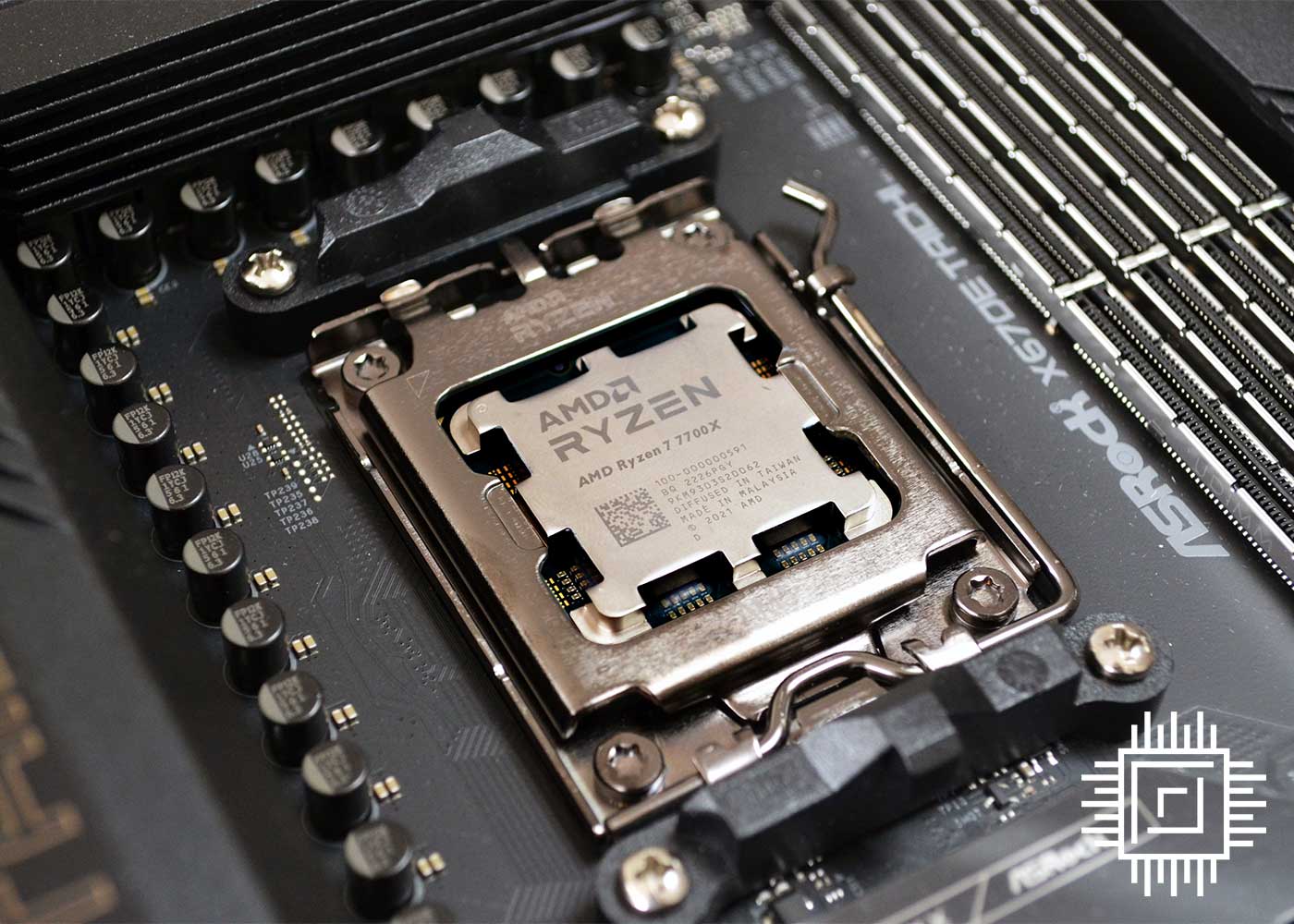

AMD Ryzen 7 7700X
£399 / $399
Pros
- Awesome 8C16T perf
- Lofty clock speeds
- Forward-looking platform
- Great choice for gaming
- Integrated graphics
Cons
- Demands good cooling
- 12C24T 5900X a pain
Club386 may earn an affiliate commission when you purchase products through links on our site.
How we test and review products.
Phase four of the Ryzen CPU Universe will see the goodness of Zen 4 extend across all product segments from laptop to enterprise. Today marks arrival on desktop with the aforementioned quartet of chips. Let’s bring out the table to see exactly where they fit in.
| Model | Architecture | Cores / Threads | TDP | L3 Cache | Base Clock | Boost Clock | Launch MSRP |
|---|---|---|---|---|---|---|---|
| Ryzen 9 7950X | 5nm Zen 4 | 16 / 32 | 170W | 64MB | 4.7GHz | 5.7GHz | $699 |
| Ryzen 9 5950X | 7nm Zen 3 | 16 / 32 | 105W | 64MB | 3.4GHz | 4.9GHz | $799 |
| Ryzen 9 7900X | 5nm Zen 4 | 12 / 24 | 170W | 64MB | 4.7GHz | 5.6GHz | $549 |
| Ryzen 9 5900X | 7nm Zen 3 | 12 / 24 | 105W | 64MB | 3.7GHz | 4.8GHz | $549 |
| Ryzen 7 5800X3D | 7nm Zen 3 | 8 / 16 | 105W | 96MB | 3.4GHz | 4.5GHz | $449 |
| Ryzen 7 5800X | 7nm Zen 3 | 8 / 16 | 105W | 32MB | 3.8GHz | 4.7GHz | $449 |
| Ryzen 7 7700X | 5nm Zen 4 | 8 / 16 | 105W | 32MB | 4.5GHz | 5.4GHz | $399 |
| Ryzen 7 5700X | 7nm Zen 3 | 8 / 16 | 65W | 32MB | 3.4GHz | 4.6GHz | $299 |
| Ryzen 5 7600X | 5nm Zen 4 | 6 / 12 | 105W | 32MB | 4.7GHz | 5.3GHz | $299 |
| Ryzen 5 5600X | 7nm Zen 3 | 6 / 12 | 65W | 32MB | 3.7GHz | 4.6GHz | $299 |
Taking a broad overview, AMD is keeping to what has thus far proved a winning formula. Core-and-thread counts remain identical to the previous generation, price points are by-and-large comparable, but there are wholesale changes elsewhere.
Switching to a cutting-edge 5nm fabrication process coincides with the introduction of a new AM5 socket, which in turn represents a unique outlook for those contemplating an upgrade. Longstanding AM4 has finally fallen out of favour – you can call time on that X370 you’ve been clinging to – and AM5 brings with it new opportunity, including compulsory support for DDR5 memory and CPU-integrated Radeon graphics.
Platform upgrades aside, what is clear from the specification table is that Zen 4 liberally employs more power and heightened frequencies in order to turn the performance dial up to 11. CPU TDP at the top end of the spectrum climbs from 105W to 170W – a whopping 62 per cent bump – and clock speeds scale accordingly. Putting the increase into perspective, base clock of Zen 4 parts is almost as quick as boosts clock of previous-gen Zen 3.
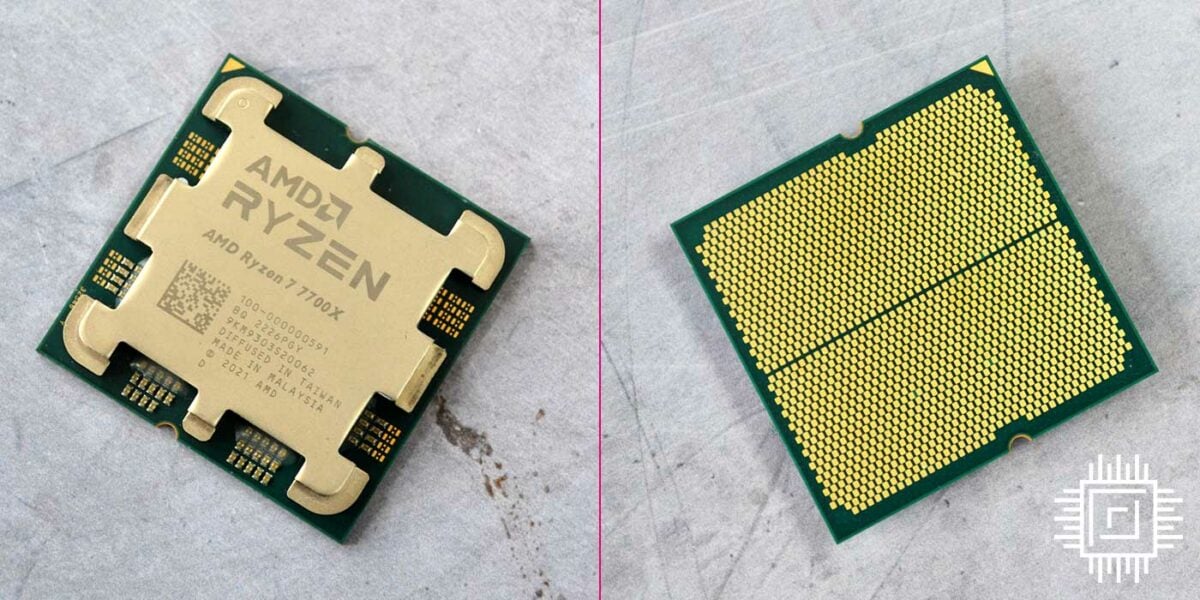
Top-dog Ryzen 9 7950X will naturally get a lot of launch-day attention – rightly so, it is a formidable chip – yet things are equally interesting further down the Zen 4 stack. Firstly, the fabled Ryzen 7 7800X3D is conspicuous by its absence. We fully expect AMD to fill that void at a later date, and die-hard gamers may feel inclined to wait for a cache-laden part known to excel in gaming workloads.
Secondly, once you’ve devoured our architectural analysis and in-depth benchmarks, there remains the question of which chip to go for? Ryzen 7000 Series is a safe bet for platform longevity, and of the initial quartet, Ryzen 7 7700X is our preferred choice. TDP is kept to 105W – a meaningful metric in this age of soaring energy prices – and an eight-core, 16-thread configuration remains a sweet spot for everyday use and high-end gaming. You can jump straight to the all-important benchmarks if that way inclined, but first, a recap on what makes Zen 4-powered Ryzen 7000 Series tick.
Zen 4 Architecture
Each evolution of a base architecture presents designers with an opportunity of doing things better. The beating heart of Ryzen 7000 Series is Zen 4, which is the brain that powers CPU cores. Like before, up to two core complexes – each carrying eight cores and 16 threads – hook up to a central input/out die (IOD). The devil is in the details when teasing out gen-on-gen improvements.
Outside of hard-nosed architecture refinements – steady your horses, technical readers – AMD doubles each core’s L2 cache from 512KB to 1MB, though closer-to-the-core L1 and more distant L3 remain at Ryzen 5000 series per-core levels of 64KB and 4MB, respectively.
But wait a second, doesn’t adding more cache balloon the transistor count and, potentially, die space? Yes, it does, but AMD’s magic trick is in adopting foundry partner TSMC’s 5nm high-performance process, down from 7nm used since 2019, and the net effect Zen 4 is able to shoehorn >50 per cent transistors yet take up less space. David Copperfield would be proud.
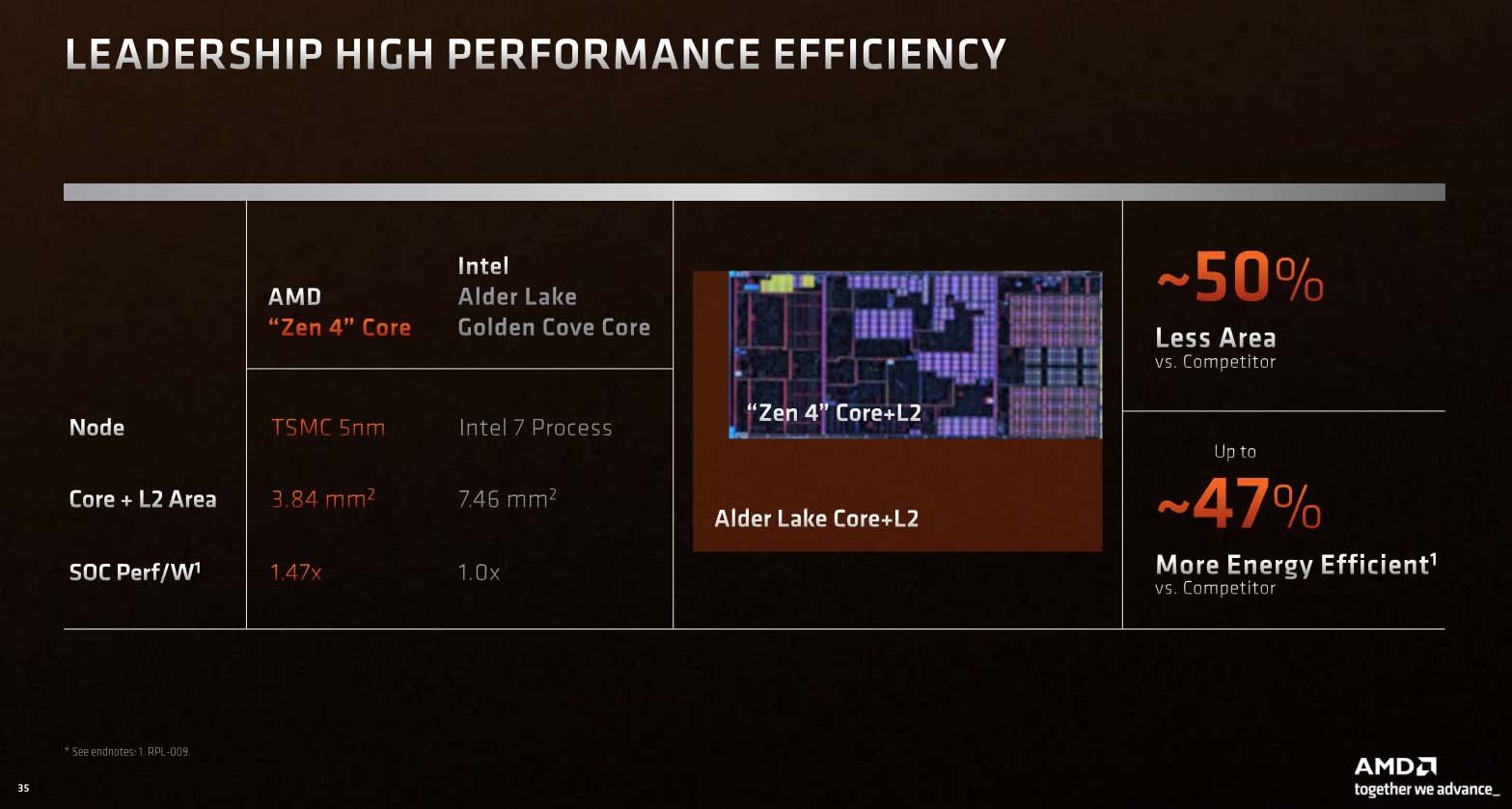
AMD takes an overt swipe at rival Intel by declaring each Zen 4 core and associated L2 is almost half the size of 12th Gen Golden Cove cores and their L2 cache. Hard to argue against that from a manufacturing viewpoint.
| Zen 4 | Zen 3 | |
|---|---|---|
| CPU fabrication process | 5nm | 7nm |
| CPU die size | 71mm² | 80.7mm² |
| CPU transistors | 6.50bn | 4.15bn |
| IOD fabrication process | 6nm | 12nm |
| IOD die size | 122mm² | 125mm² |
| IOD transistors | 3.40bn | 2.09bn |
New GPU-Laden IOD
AMD also invests a lot of extra silicon to the IOD die, which shrinks from 12nm to 6nm for the latest chips. Finding out where the extra 1.31bn transistors go is actually easy. As the IOD controls external interfaces to features such as memory and connectivity, there’s some extra die space apportioned there.
But that’s not the whole shebang. AMD grasps the die-size reduction opportunity with both hands and integrates graphics into the IOD. The question isn’t one of why, but one of why not, given the graphics heritage imbued in the company.
All Ryzen 7000 Series CPUs carry RDNA 2 graphics as standard. Don’t get too excited and think you can ditch that Radeon RX 6600 XT or GeForce RTX 3060. That’s not happening as the IGP is comprised of a two-CU, 128-shader cluster pulled over from mobile technology.
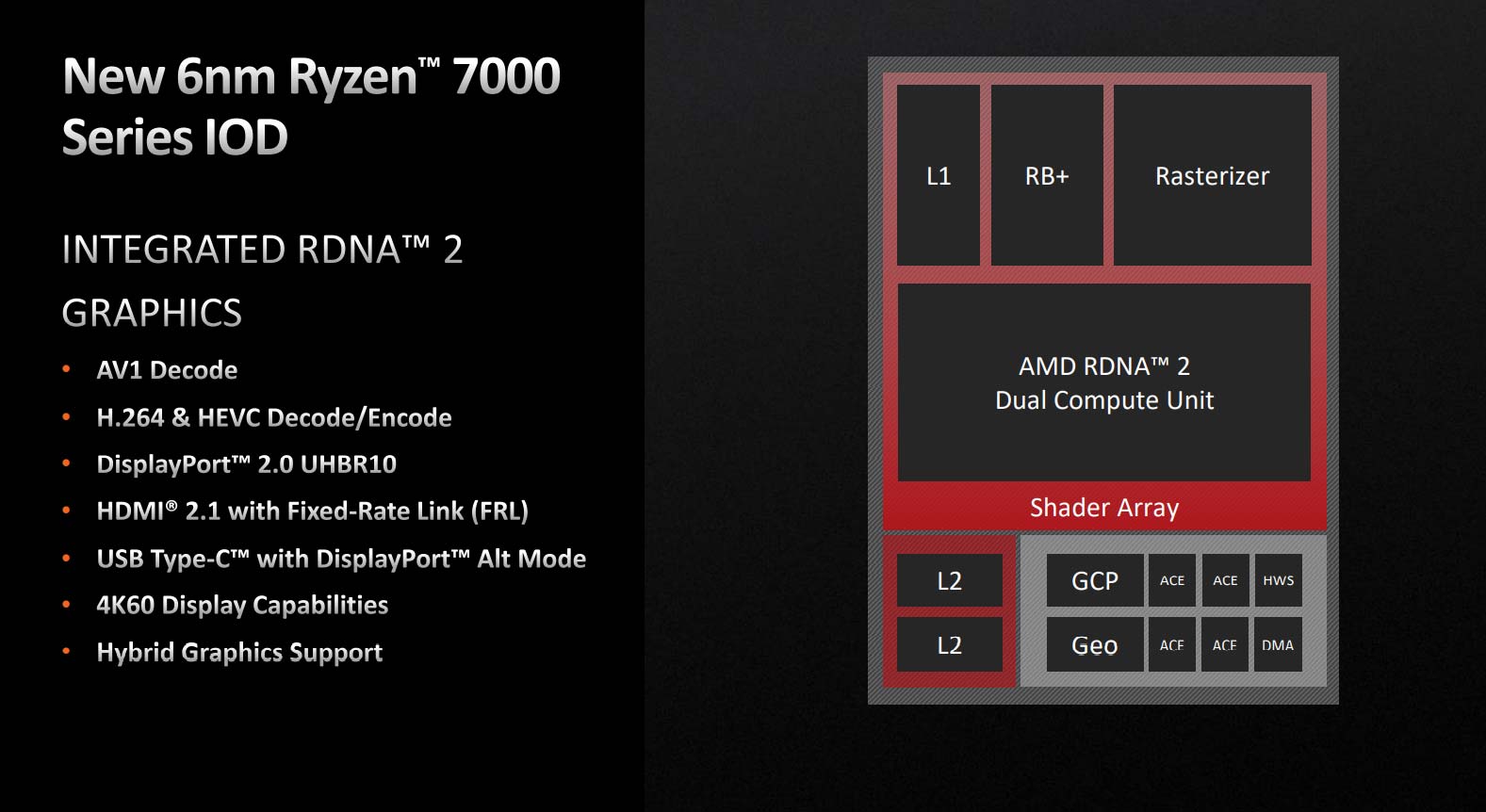
The main purpose of these graphics is to enable all Ryzen 7000 Series CPUs to fit into systems that don’t require heavy GPU capability. Truth be told, that’s millions upon millions of PCs, and AMD has historically required add-in discrete cards for most 5000 Series chips or resorted to a few G Series. Intel, on the other hand, has been mining this rich volume seam for years with low-power, flexible-output IGPs baked into each generation of Core. AMD wants a slice or two of that pie.
The two-CU GPU arrangement is eerily similar to the built-in graphics on just-announced Ryzen 7020 Series processors. Expect a pinch of gaming performance for light-load eSports titles played at, say, 720p with basic settings, yet display flexibility is arguably as important. The GPU features a strong roster of encode/decode abilities and display outputs – certainly enough not to need a discrete card in a small-form-factor PC. AMD has severed the necessary link between most Ryzen processors and discrete cards, and that’s a good thing.
What’s Going On, Zen 4
Resident CPU guru and known as ‘father of Zen’ in close-knit circles, Mike Clark headlined the recent Architecture Day by positing Zen 4 enjoys a geomean average 13 per cent instructions-per-cycle (IPC) uplift over in-market Zen 3, judged at the same frequency.
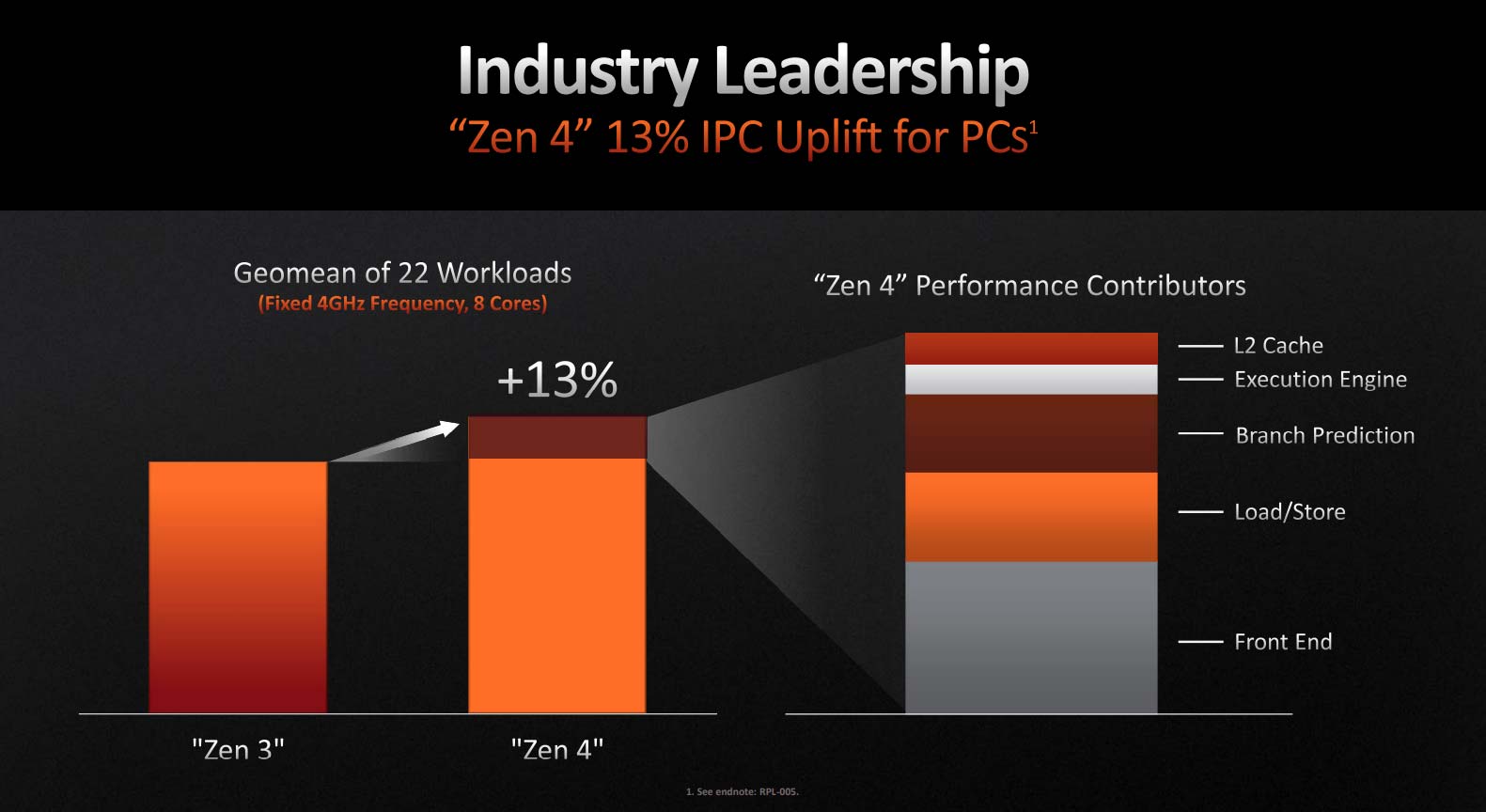
As frequency and not IPC is the main driver of Ryzen 7000 Series’ performance progression over the previous generation, we’re okay with the apples-to-apples uplift. It’s actually surprising how little extra performance is provided by the doubling of per-core L2 cache, bringing into question where it was necessary for this round of chips. Most of the gains – around 80 per cent or so – emanate from three areas: the front-end, load/store, and branch prediction.
This is telling insofar as most of the architectural tweaks derive from optimisations to what’s referred to as ‘feeding the beast.’
Front-end and branch prediction advances afford the largest portion of IPC gain – somewhere in the region of 60 per cent – and the key here is the increase in the size and processing ability of operation cache. The reasoning is simple enough because Zen 4, like its predecessor, keeps to a decode rate of four regular instructions per cycle, which is weak when the queue can dispatch six into the execution engines.
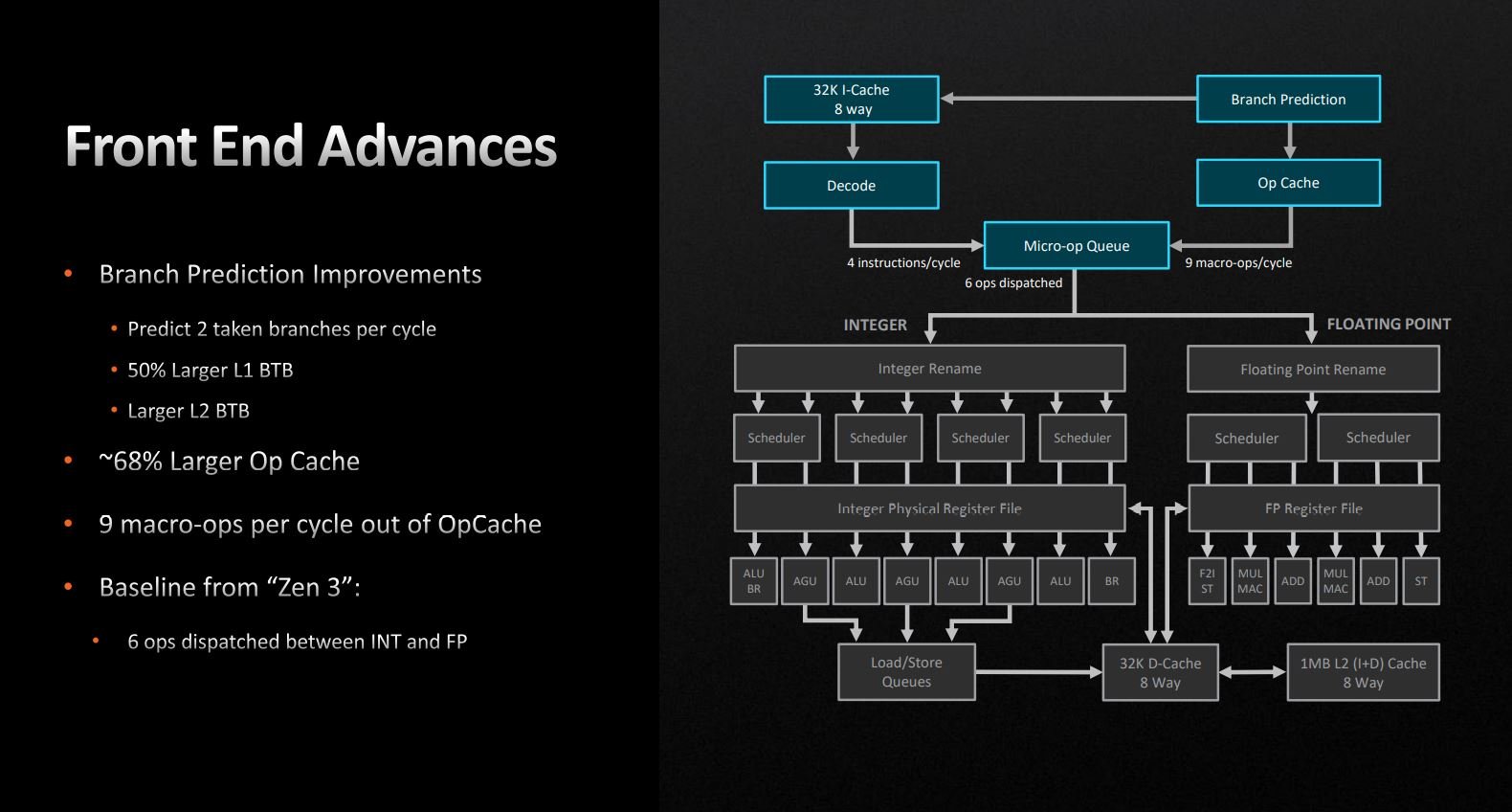
AMD got around this by having a 4K L0 op-cache on Zen 3, but this is increased to around 7K on Zen 4, alongside larger supporting buffers. And that’s been a hallmark of Zen evolution over the years. Zen 2, for example, had an L1 Branch Target Buffer (BTB) of only 512 entries; Zen 3 increased that to 1,024, and Zen 4 goes up to 1,536 entries. It wouldn’t surprise us one iota if Zen 5 doubles buffer and cache sizes again.
The easiest way to visualise the overall benefit is to imagine the front-end being a funnel into the core’s engine – the wider and more efficient it is, the better one can saturate the execution engines. Some of the most sought-after CPU architects are high-quality front-end merchants… and with good reason.
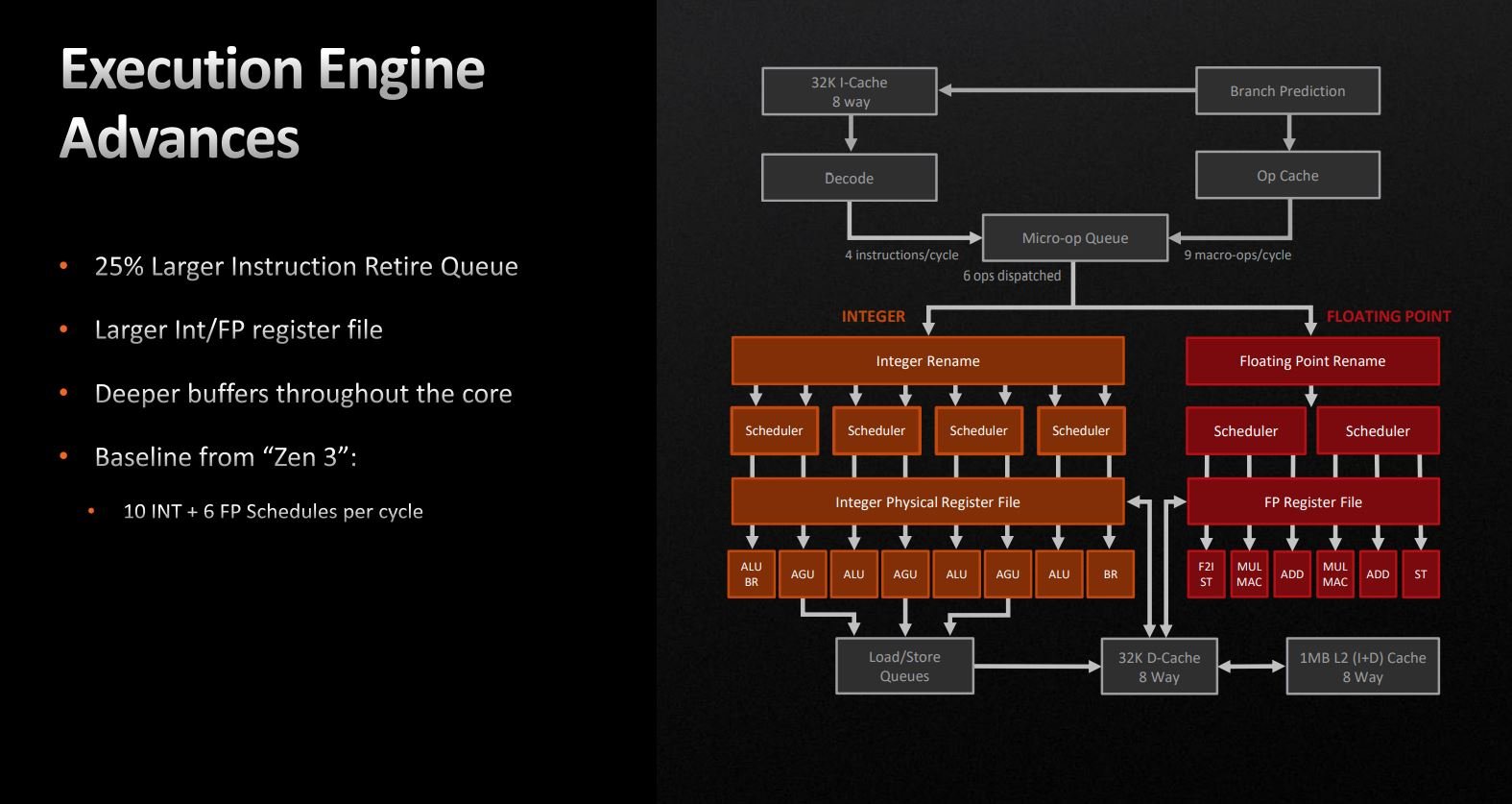
If you’re going to feed the beast more, it better have the stomach to digest bigger portions. This is where larger instruction retire queues and register files come into play. Adding them takes transistor space, explaining why Zen 4 is fundamentally larger than Zen 3, though it’s considered worth the expense as performance benefits outweigh the cost of implementation.
Moving on down to load/store units, Zen 4 goes, you guessed it, larger in areas that matter. Of particular note is the 50 per cent increase in L2 DTLB, though from what we can glean, it may be less associative.
This birds-eye view of key changes reinforces the message doled out above. AMD spends most of Zen 4’s additional resource into expanding buffers, caches and queues. The downside of doing so is increased latency out to larger, slower L2 and L3 caches, yet a few cycles can be masked by more in-flight processing.
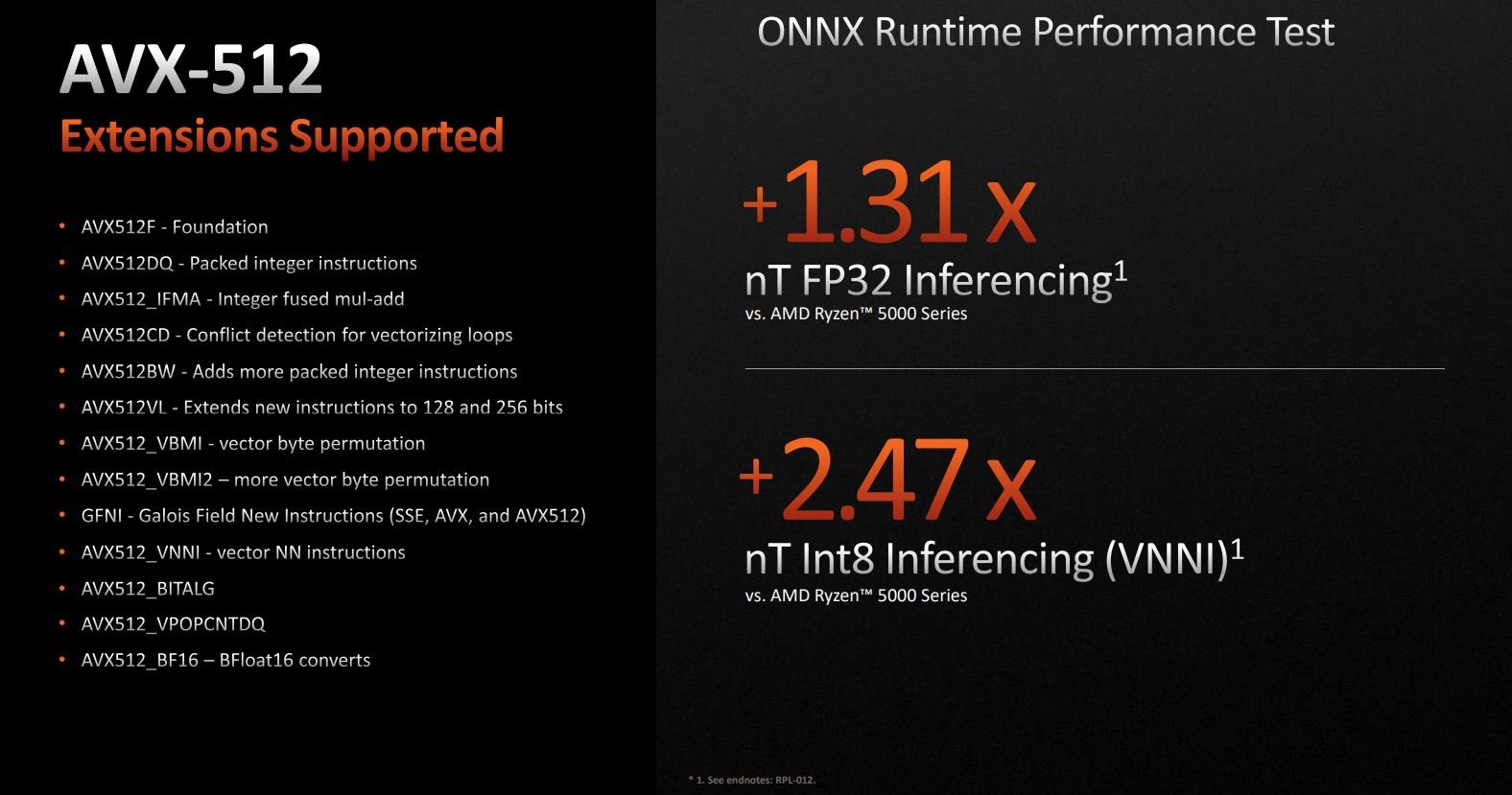
Did we forget to mention AVX-512 support? How remiss. Zen 4 does indeed support most of the feature-set but does so in an interesting way. Rather than go for a single, 512-wide ALU, which is the optimal but expensive way, AMD chooses to double-pump 256-bit-wide instructions. This approach is slower than a native implementation, of course, and Zen 4 does it this way, we imagine, in order not to hurt frequency too much. Full-on AVX-512 workloads have a habit of dragging speeds down and thermals up.
Going double-pump, though not ideal, is a good middle ground for consumer processors and fits neatly between regular AVX-256 and proper AVX-512 performance. Showing how noisome AVX-512 can be, Intel officially doesn’t support it on recent 12th Gen Alder Lake processors, which naturally puts AMD at an advantage in specific media workloads. Being fair, there’s little in the way of AVX-512-optimised software at the moment, yet AMD jumps on the mantra of if you build it, they will come.
Fight For Frequency
Design decisions within Zen 4 all tell one story. Architecture refinements play second fiddle to the quest for much higher frequency than available on Zen 3. According to all-round AMD genius Joe Macri, a multi-year collaboration with foundry partner TSMC, which has become closer over time, has enabled the duo to fine-tune high-performance 5nm silicon for elevated clocks.
The exact nature of the silicon remains unknown, but we do know AMD actually failed in the original aim of releasing Zen 4 with a top-bin speed of 6GHz. As 5nm matures, AMD may take very select dies and launch a wattage-unencumbered ‘Ryzen 9 7990X’ with that seminal frequency. But hey, 5.7GHz ain’t bad right out of the gate. Rival Intel appears to have beaten AMD to the 6GHz punch by sort of announcing the upcoming Core i9-13900KS.
Stratospheric single-thread speeds are all well and fine. We’re more impressed by the multi-core prowess of Ryzen 9 7950X, which hovers on the right side of 5GHz when everything is run at 11. Oops, letting the proverbial cat out of the benchmark bag there.
Packaging Opportunities – AM5
AMD’s mainstream chips since 2017 have been resident on the AM4 platform. Fantastic socket longevity provides ample upgrading opportunities over time, considered one of AMD’s key strengths – Ryzen 9 5950X, for example, can be run on select X370 motherboards from way back when – but is an obstacle when designing feature-rich, powerful platforms for the next five years. Something has to give, and in this case, AM4 is the sacrificial lamb.
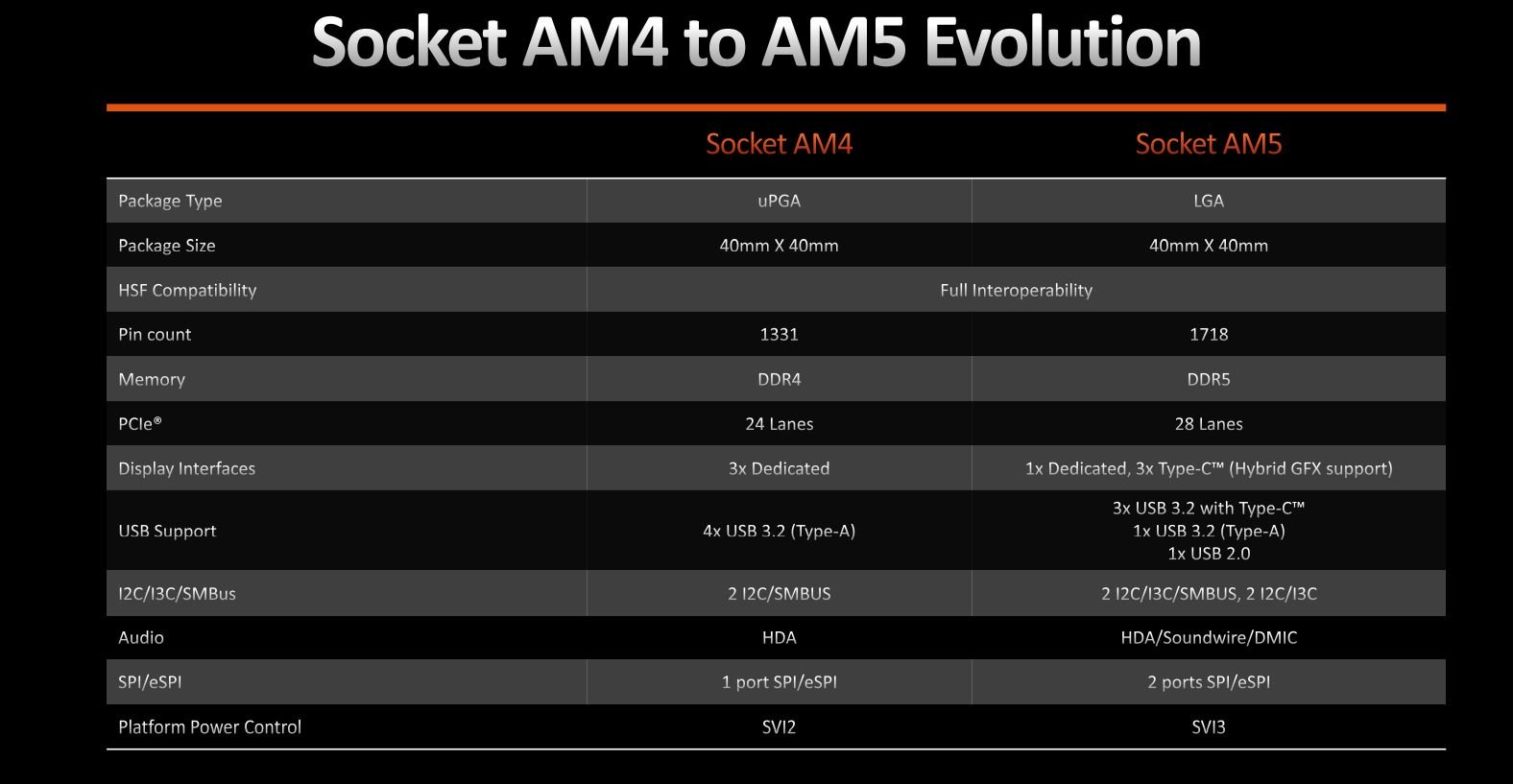
Which all leads me on to the second point about Ryzen 7000 Series. The chips use the AM5 form factor that’s just not compatible with gnarly, old AM4. You see, AMD transitions to an LGA1718 socket from PGA1334, meaning the pins are located on the motherboard, not the CPU, as is the case with AM4.
AM4, it has to be said, is the outlier in AMD’s processor stable. High-performance Threadripper (Pro) and server-optimised Epyc have been on an LGA footing since time immemorial; AM5 joins them. No more bent pins on the CPU, though watch out for dropping anything in the socket! In a concession to legion enthusiasts, AMD doesn’t change the 40mm x 40mm socket area, meaning you can re-use AM4 cooling. Another plus point is motherboard makers don’t have to completely redesign boards. A win-win.
Back on point, it’s the extra 29 per cent of pinnage that largely enables AMD to feed high-end beasts with more power. Sure, AM4 could scale high with lots of voltage, but it wasn’t designed to run close to 200W – AM5, on the other hand, laps it up. Extra routing pins also offer plenty of scope to add more features and performance in the future. With all that in mind, I believe shifting the entire mainstream ecosystem is the right idea, even if it doles out short-term pain by closing long-in-the-tooth upgrade paths.
DDR5 – The Only Show In Town
Five appears to be the magic number. AMD makes the move to DDR5 memory almost a year after Intel brought it to the mainstream with 12th Gen Core. Unlike its rival, Ryzen doesn’t bother with also carrying DDR4 compatibility. Want Ryzen 7000 Series, you better budget for DDR5 memory.
The good news is DDR5 memory is becoming more affordable each passing month. A high-performance 32GB kit is available for around £200, which is about 50 per cent more than the cost of enthusiast-grade DDR4. £70 premium for memory is small beer when considered in the wider sense, so whilst DDR4 support would have been nice, especially for budget builds featuring lower-end Ryzen 7000 chips, it ain’t a deal breaker.
One man’s dual-channel DDR5 implementation isn’t the same as another’s. AMD’s distils down as follows:
| Configuration | Maximum speed |
|---|---|
| 1x single-rank | 5,200MT/s |
| 1x dual-rank | 5,200MT/s |
| 2x single-rank | 3,600MT/s |
| 2x dual-rank | 3,600MT/s |
The takeaway is simple. Sticking four modules into a motherboard results in officially supported speed dropping from a nice 5200MT/s to just 3,600MT/s. Sure, most enthusiast boards will offer much higher speeds, and run stably at that, yet the steep frequency drop-off isn’t ideal. Put simply, run with two modules if you can. Now where are those 64GB modules running at 6600MT/s?
Getting granular on a platform level, you may remember Ryzen 5000 Series CPUs tied the internal memory clock speed to Infinity Fabric speed and integrated memory controller. This changes on Ryzen 7000 Series because of the higher speeds offered by DDR5. In practise, internal RAM speed is still run on a 1:1 ratio with the IMC but the Fabric clock drops down to a 3:2 ratio.
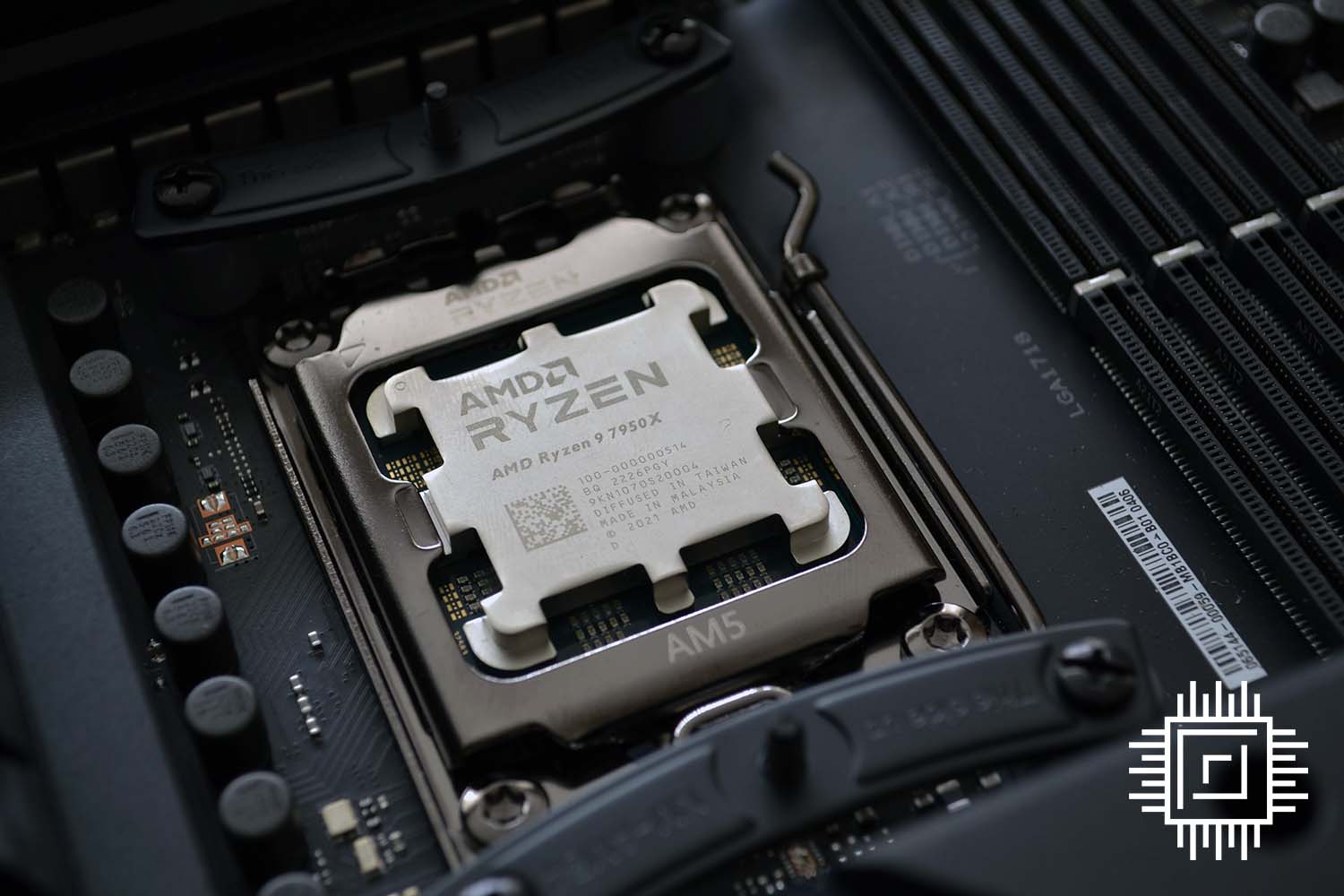
Let’s take an example of DDR5-5200 memory. It actually runs at 2,600MHz internally, which ties to the frequency of the IMC (also 2,600MHz). Infinity Fabric, meanwhile, runs at 1,733MHz on a 3:2 ratio. Put simply, getting the IF clock to 2,600MHz is not going to happen.
You may have read about a sweet spot memory speed of DDR5-6000, and there’s good reason why that works well. The IMC also scales to 3,000MHz in that instance while IF chugs along at 2,000MHz. All good. Running past an internal 3,000MHz DDR5 clocking causes the IMC to halve in speed, while IF fidgets between 1,850-2,100MHz.
The key to fast running is symmetry. You may find application performance is marginally slower with DDR5-6400 as the IMC speed is cut to only 1,600MHz.
Chipset Bonanza
Motherboard makers lick their chops when a new socket comes out. Catering for the enthusiast first, AMD’s partners are now releasing X670E and X670 chipsets. Boards are expected to cost from £200 and scale up to, well, more paper than most wallets hold.
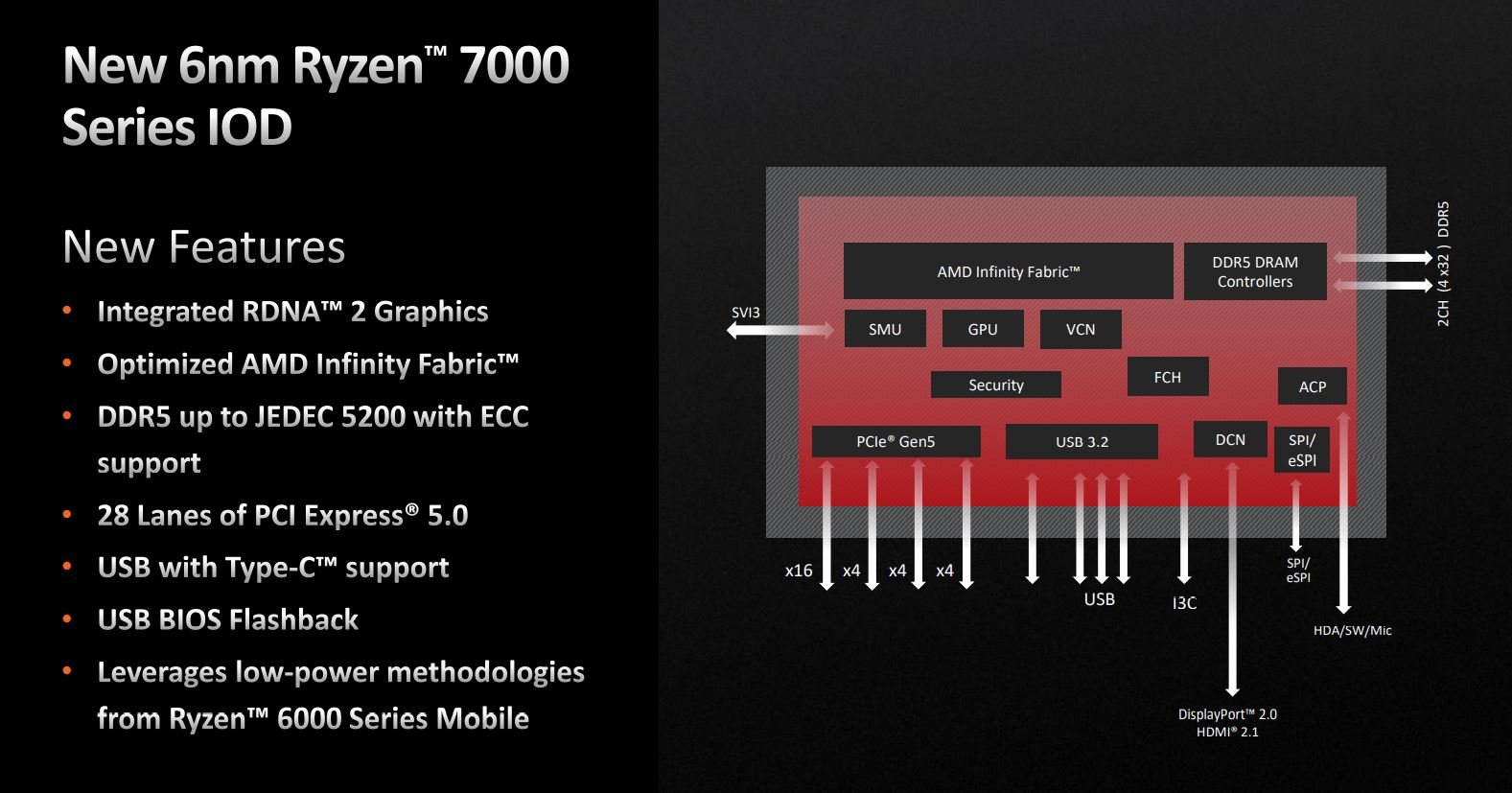
A lot of the expansion goodies are held on the IOD section of the CPU, and you will receive this connectivity mana, illustrated above, irrespective of chipset employed. Compared to Ryzen 5000 Series processors, which are still considered rich in features, AMD increases PCIe lanes from 24 to 28. That’s only half the story as Ryzen 7000 Series upgrades them to speed-loving PCIe 5.0.
This actually shakes out simply. You now have one more CPU-integrated PCIe x4 link ostensibly for additional storage, run at up to PCIe 5.0 for upcoming SSDs. In a nod toward legacy support and BIOS flashback updates, AMD further adds a single general-purpose USB 2 port.
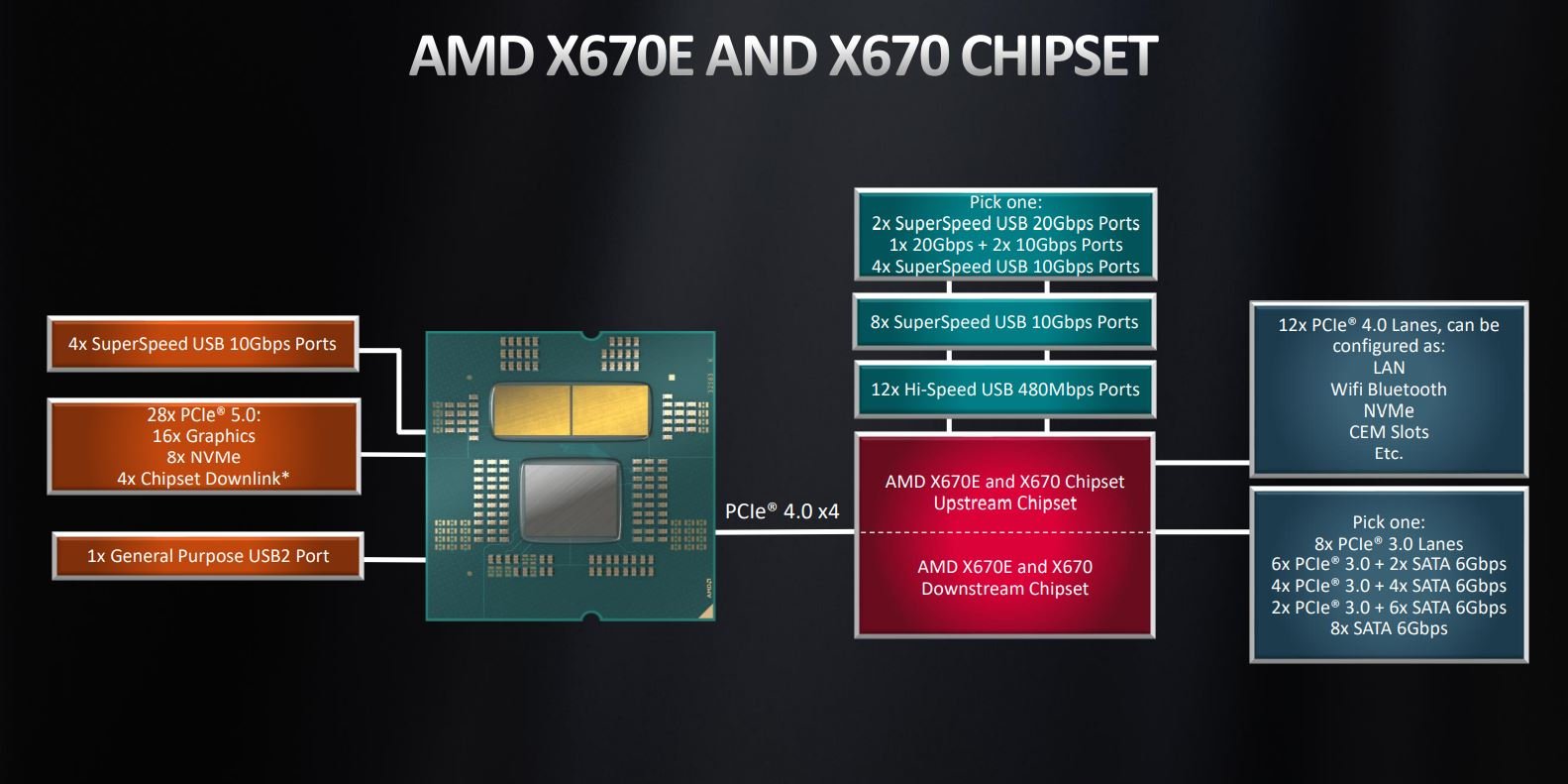
Four of the aforementioned 28 lanes emanating from the IOD portion of the chip are purposed into PCIe 4.0 for connecting the CPU to the chipset. And it is a set of chips this time around. Look closely to determine X670E and X670 utilise a two-chip solution. Known internally as Promontory 21 and built by ASMedia, both are not connected directly to the CPU. Rather, only the first is via the shown PCIe 4.0 x4 link. The second daisy-chains to the first via another PCIe 4.0 x4 internal link and has to run through it to pass data to the processor. A downside is potentially higher access latency on the second Prom 21, but an obvious benefit of a two-chip solution is that one can double-up on connectivity without needing a single, super-large solution. Once you understand this, the decent connectivity increase in supported devices compared to X570 makes implicit sense.
New X-series is therefore able to go real heavy on USB. Remember X570 natively supported up to 12 ports – eight USB 3.2 G2, four USB 2.0 – X670/E’s two-chip solution offers up to 20 of various speeds, with the option, for the first time, to have a couple of 20Gbps rolled into the mix. Nice.
Looking across, general-purpose lanes increase from eight to 12, and AMD throws in heaps of PCIe 3.0, as well. If you’ve got the chip features and bandwidth, why ever not. Both run at around 7W full chat, which when spaced out on a motherboard is okay for operating without the fans we saw on all original X570 boards. Good news.
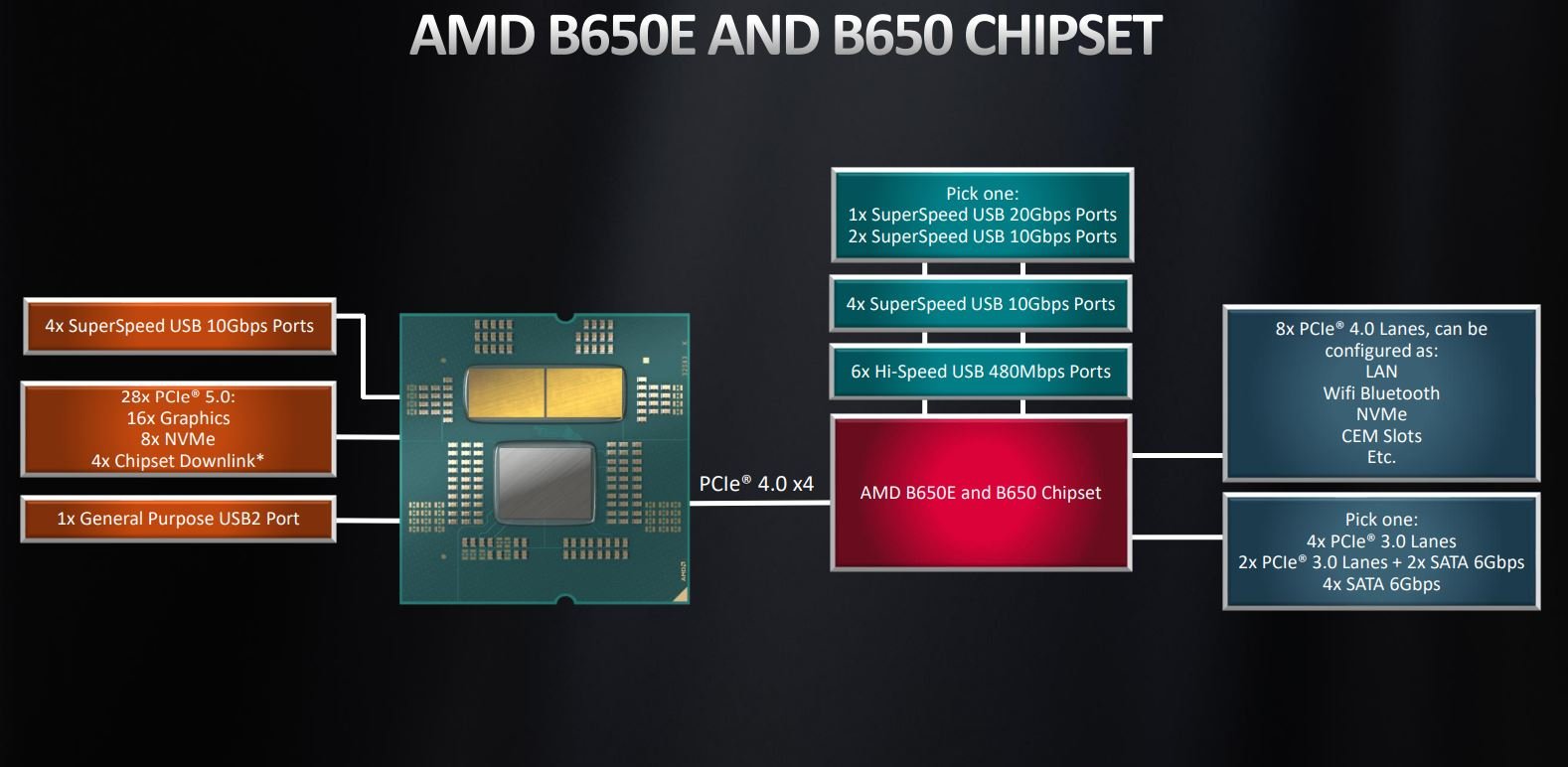
Motherboard manufacturers won’t need to add many discrete chips for a fully-fledged board, and it’s only USB 4 that’s conspicuous by its absence. Even that’s not quite the headache that it could have been; most motherboard guys with premium offerings will use either the ASMedia ASM4242 or Intel Maple Ridge two-port USB 4 host controllers running off spare CPU PCIe lanes.
Performance
We dread to think of the energy bill at Club386 HQ this past week; our test platforms have been benchmarking in overdrive! Ryzen-coloured smoke has been seen rising from the labs, where 7000 Series chips were evaluated on an Asus ROG X670E Hero motherboard outfitted with 32GB (2x16GB) of G.Skill Trident Z5 Neo EXPO memory operating at AMD’s official specification, 5,200MT/s, plus Nvidia GeForce RTX 3080 graphics and Noctua NH-D15 cooling.
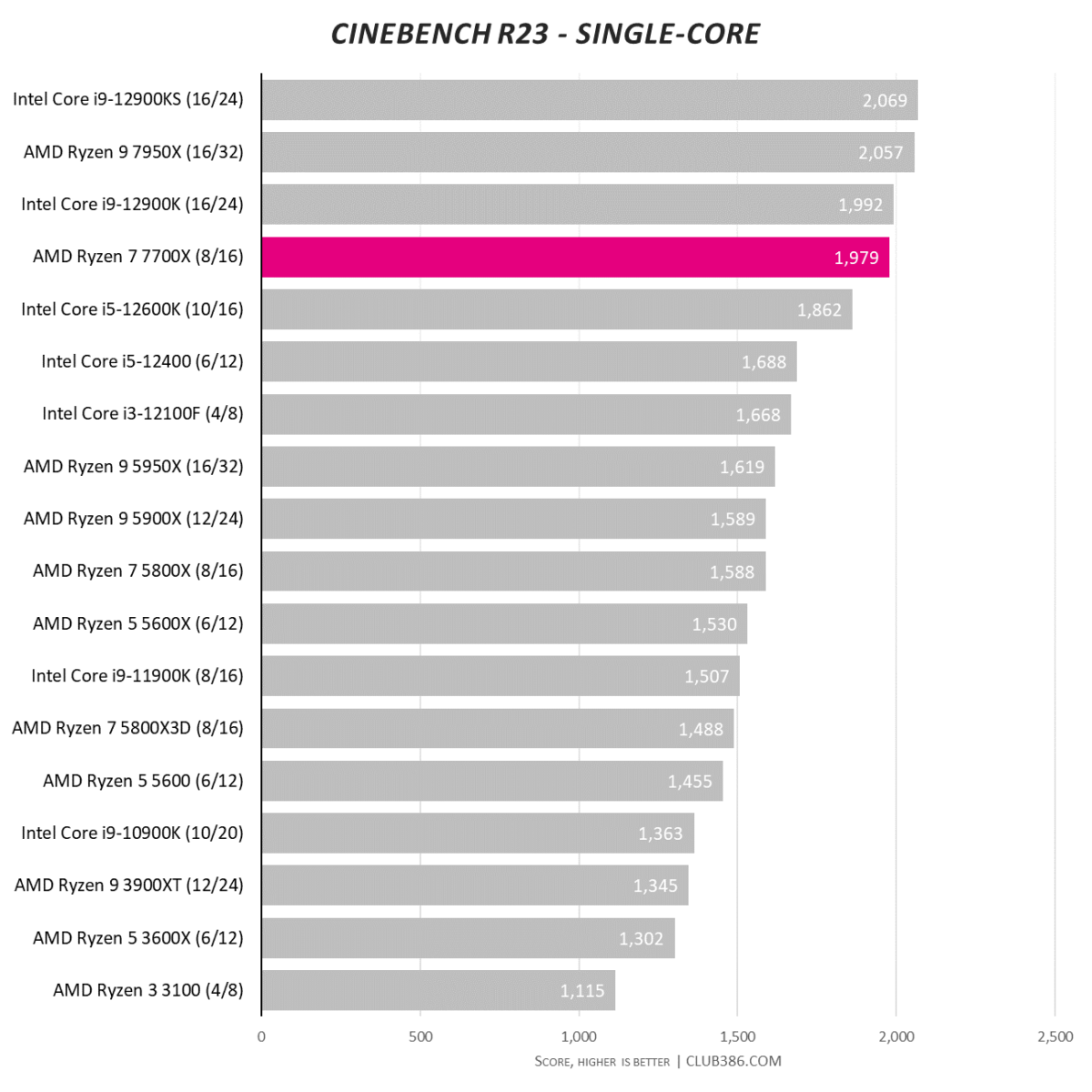
A little more IPC and a good dollop of extra frequency bodes well for any new generation of CPU. Ryzen 7 7700X routinely hits 5.55GHz with air cooling and drags itself up to fourth spot, beating AMD’s previous-generation flagship to the tune of 22 per cent.
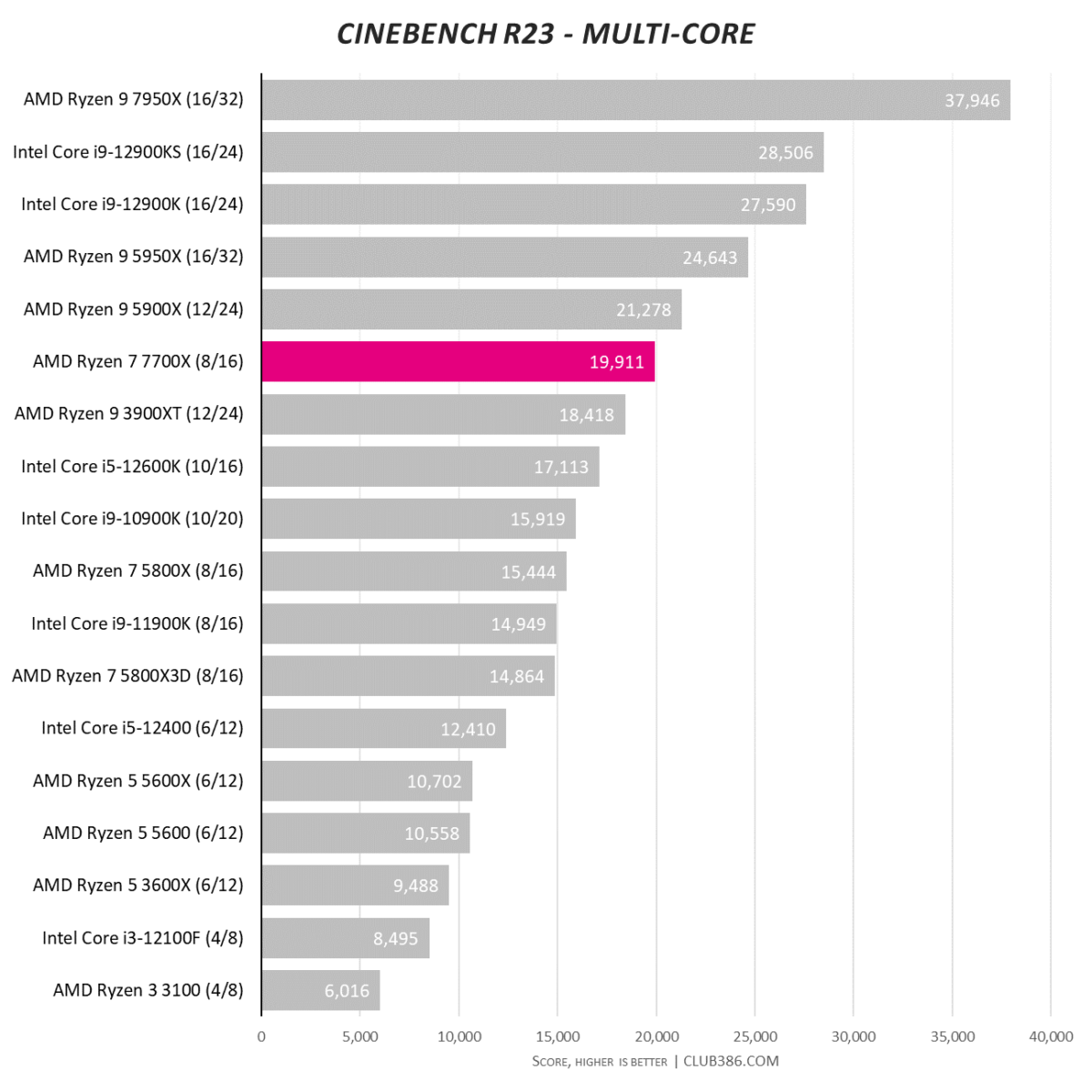
Comparing between generations, the eight-core, 16-thread Ryzen 7 7700X is found to be almost 30 per cent faster than Ryzen 7 5800X.
That gain can be largely attributed to the Zen 4 part achieving an impressive 5.2GHz all-core speed in our tests. Such lofty figures are held for extended periods without any sign of thermal throttling; after a full 10-minute stress test the Cinebench score barely wavered, returning 19,835.
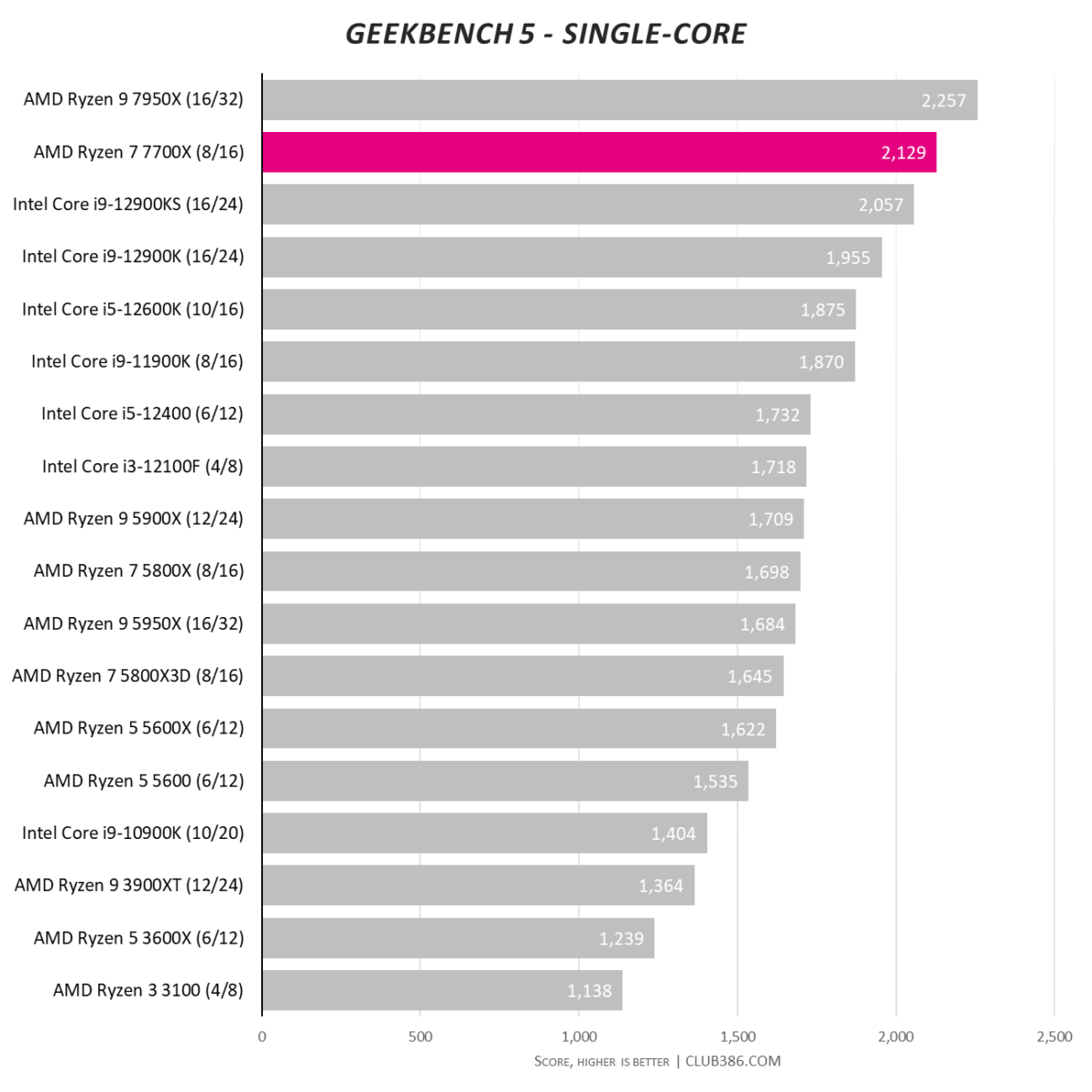
Ryzen 5000 Series played second fiddle in most single-core examinations. Ryzen 7000 CPUs right that wrong by debuting atop the Geekbench chart, though we suspect upcoming 13th Gen Intel Core ‘Raptor Lake’ will have something to say about that.
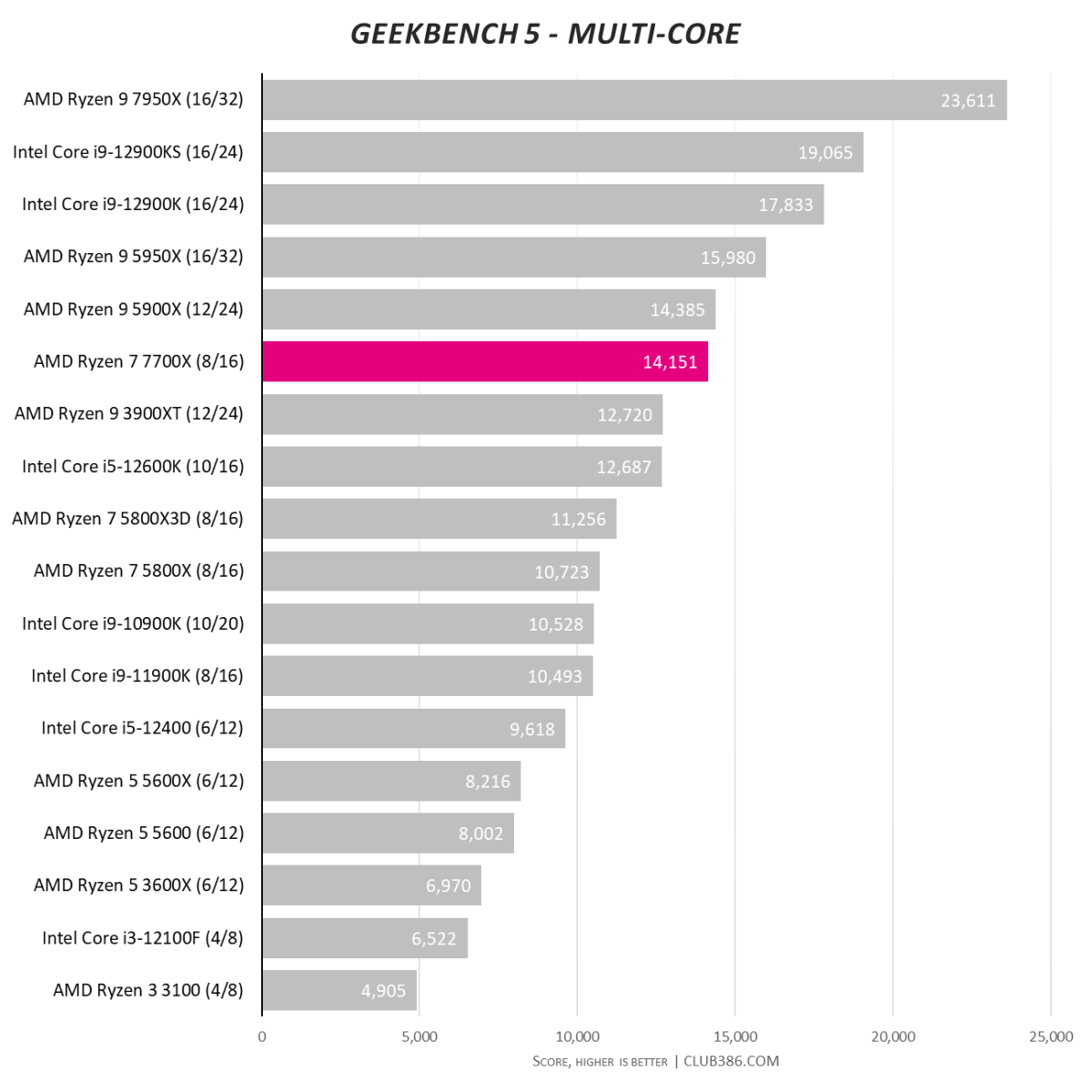
Easily the most capable eight-core CPU we’ve tested, Ryzen 7 7700X is a safe bet for productivity and content creation, but do you see the potential snag?
Yep, you guessed it; with a score of 14,385, existing Ryzen 9 5900X could be a thorn in 7700X’s side. The 12-core chip may not have latest-generation IPC smarts and heady frequency, yet you can’t argue with 24 threads, and it is no surprise AMD has moved to phase out recent price cuts. Don’t expect to find many 5900X bargains going forward.
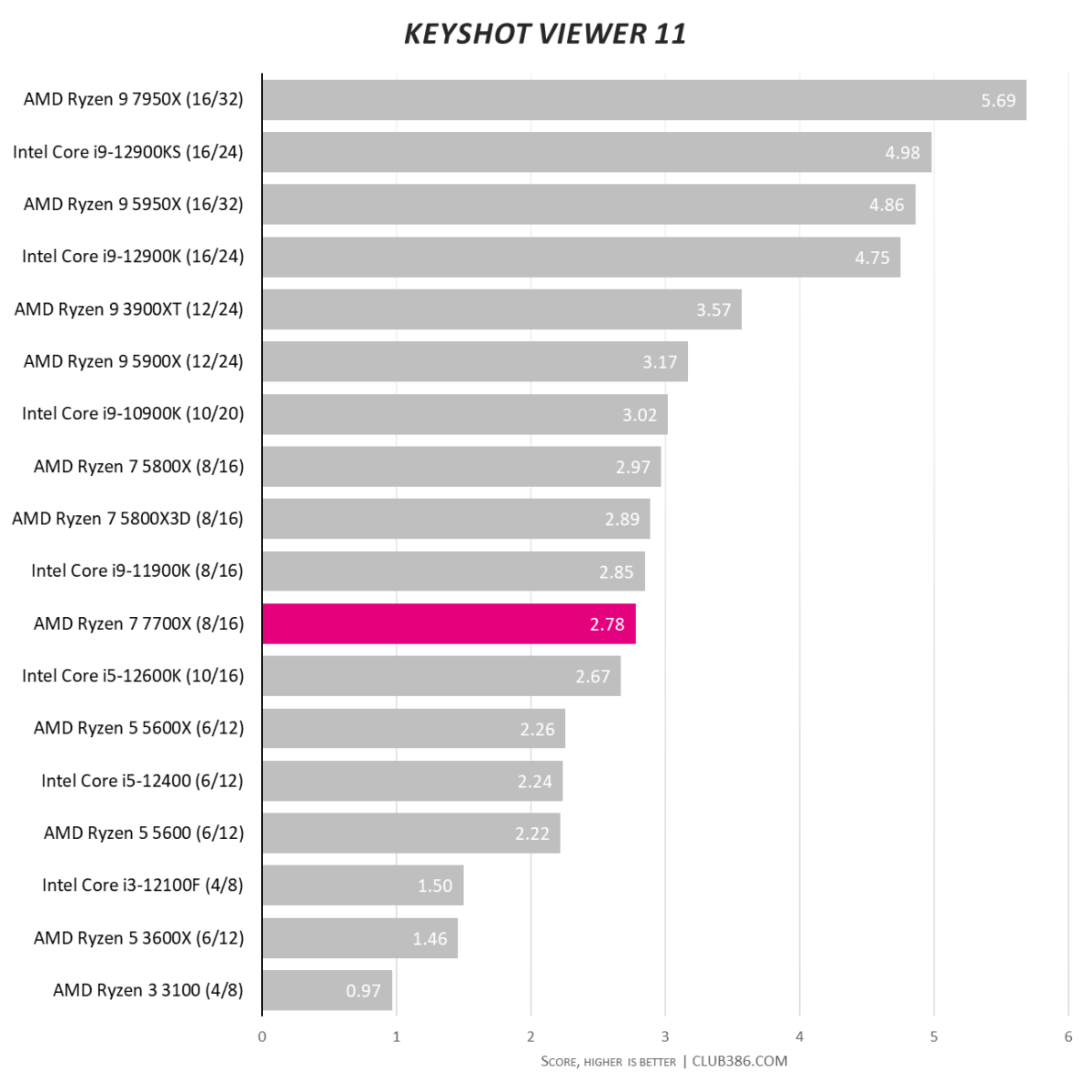
An eight-core Ryzen 7 7700X at £420 offers new platform, DDR5 and onboard graphics, but if you’re inclined to stay put, 12-core Ryzen 9 5900X remains a solid option for myriad recent AM4 boards.
Memory
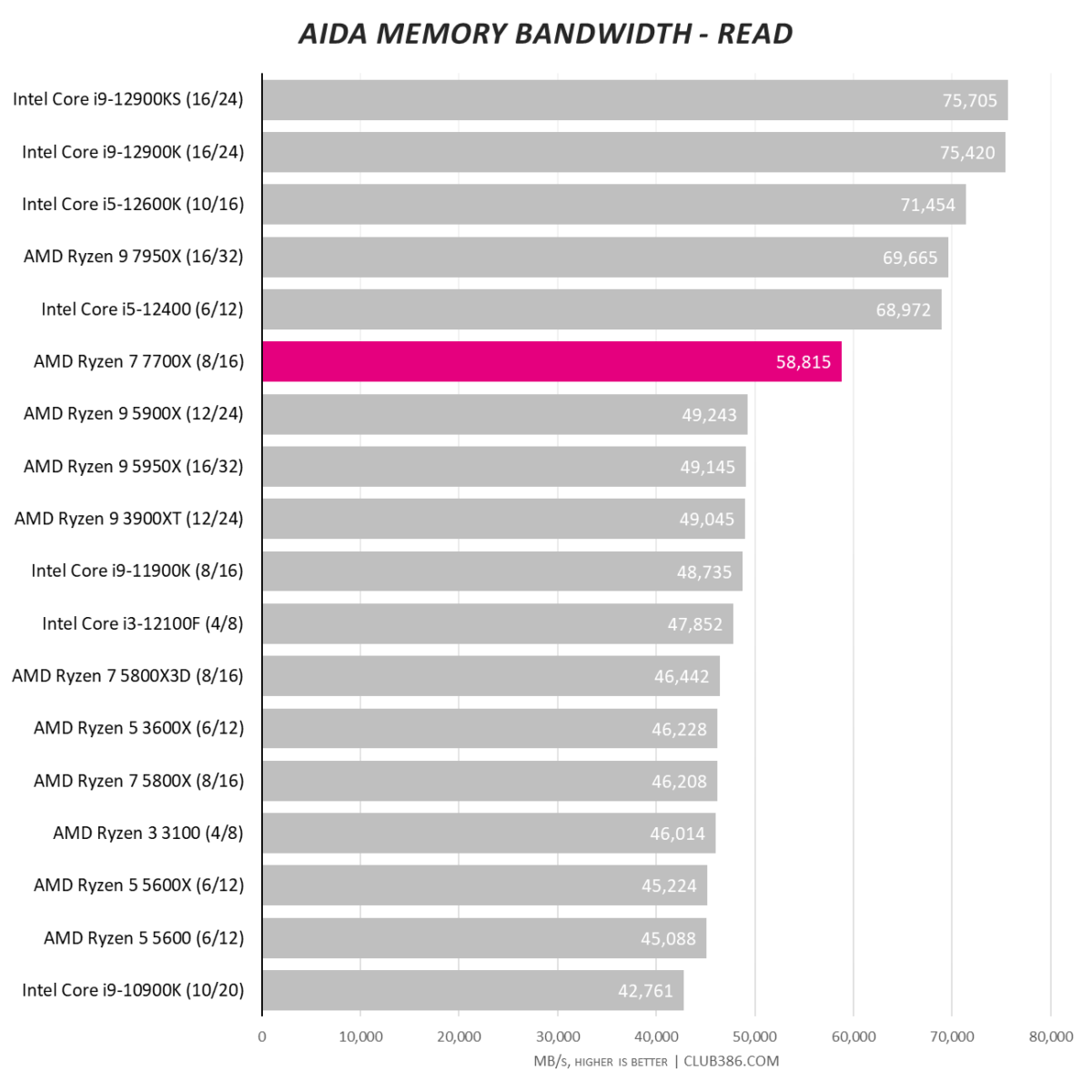
That’s odd. We’d expect memory read bandwidth to be in the region of ~70,000MB/s. Aida does state that Ryzen 7000 Series isn’t yet officially supported, so we’ll put this down to early software teething issues. No such problems on the hardware front – each and every AMD Expo memory kit we’ve tried thus far has worked first time.
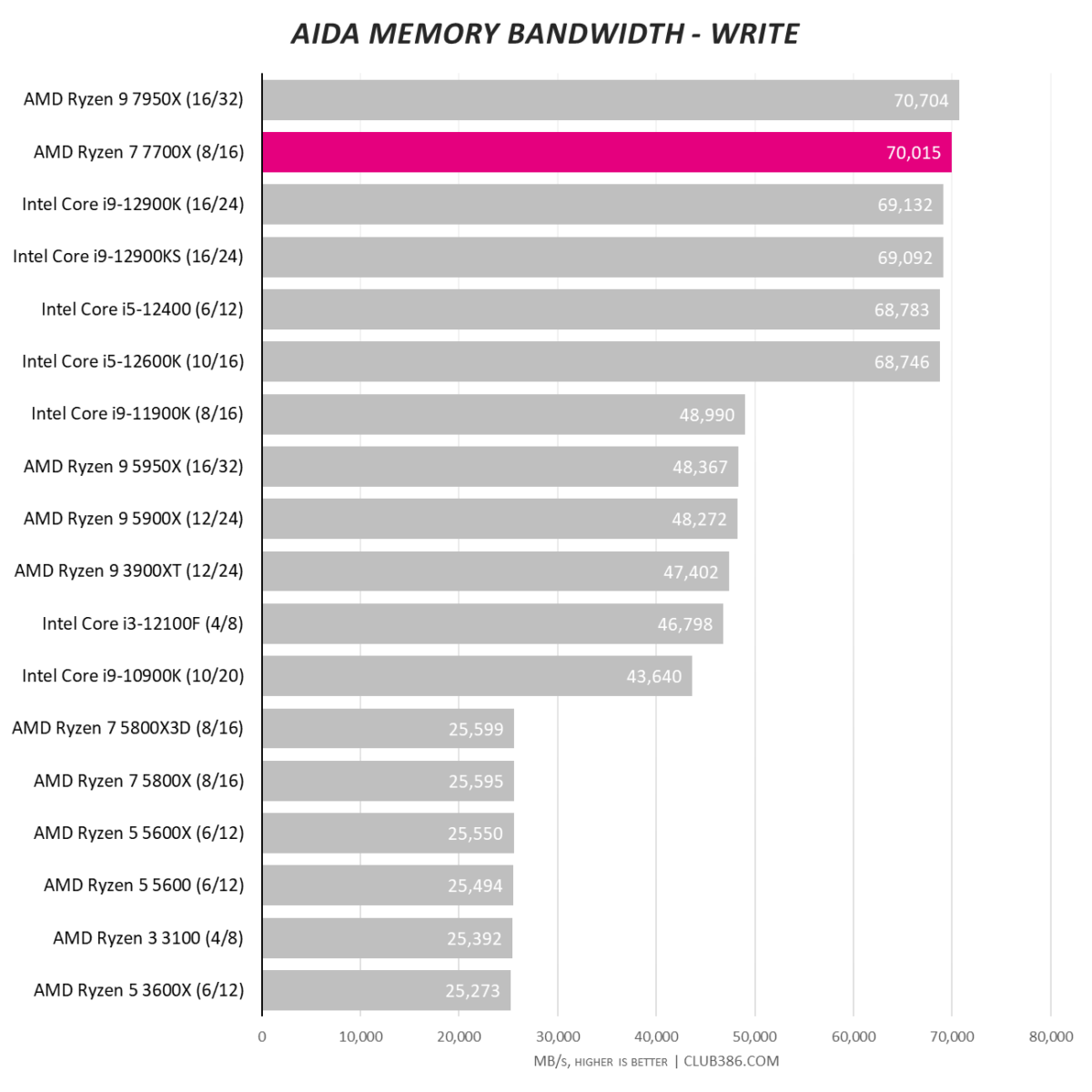
Eyebrows are raised here, too. Ryzen 7 7700X’s single-CCD configuration suggests the processor can write to memory at half controller speed (16 bytes per cycle). We’d expect write bandwidth to be around the 35,000MB/s mark and have reached out to AMD for clarification.
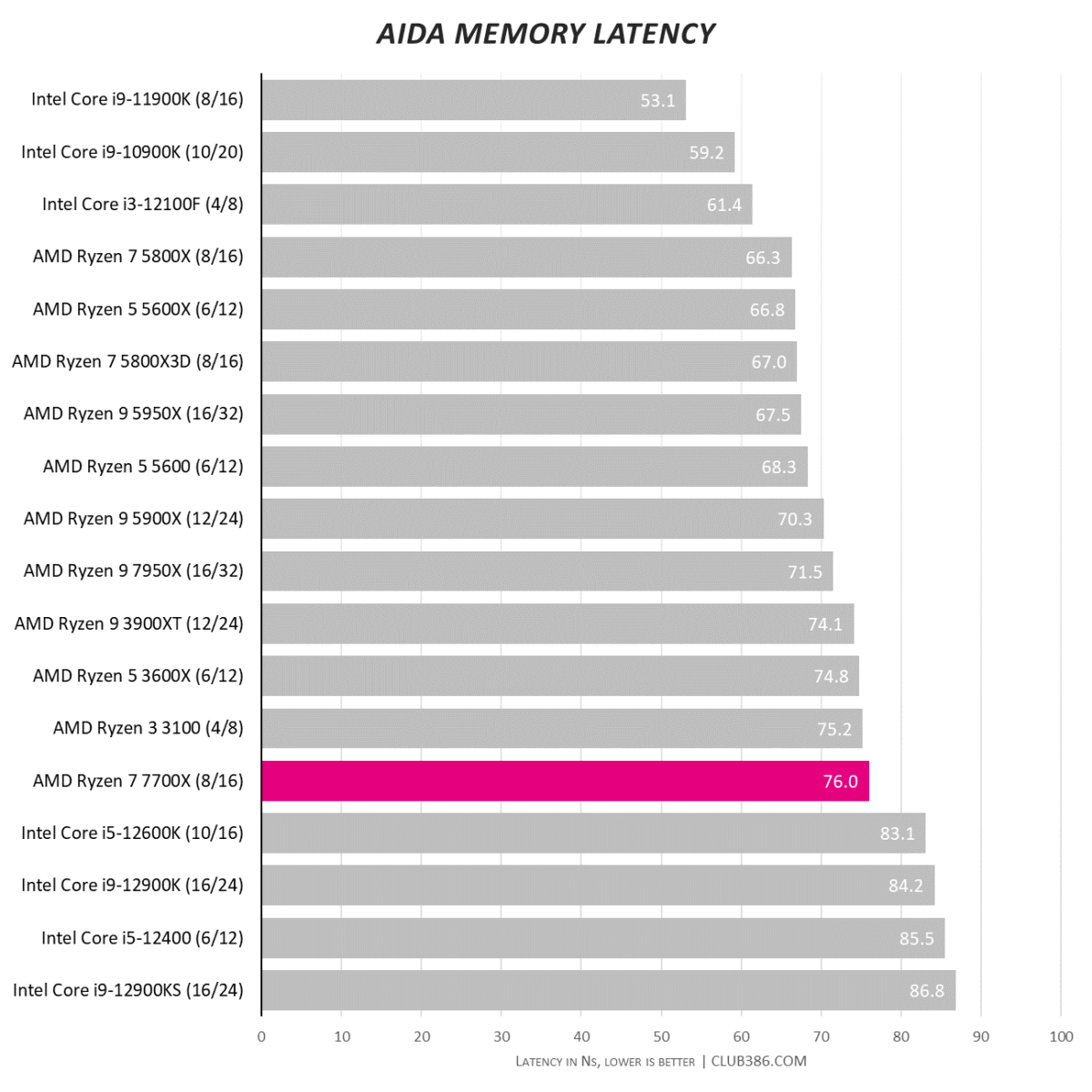
Latency remains a tad higher than outgoing DDR4, but DDR5 is maturing and heading in the right direction.
System
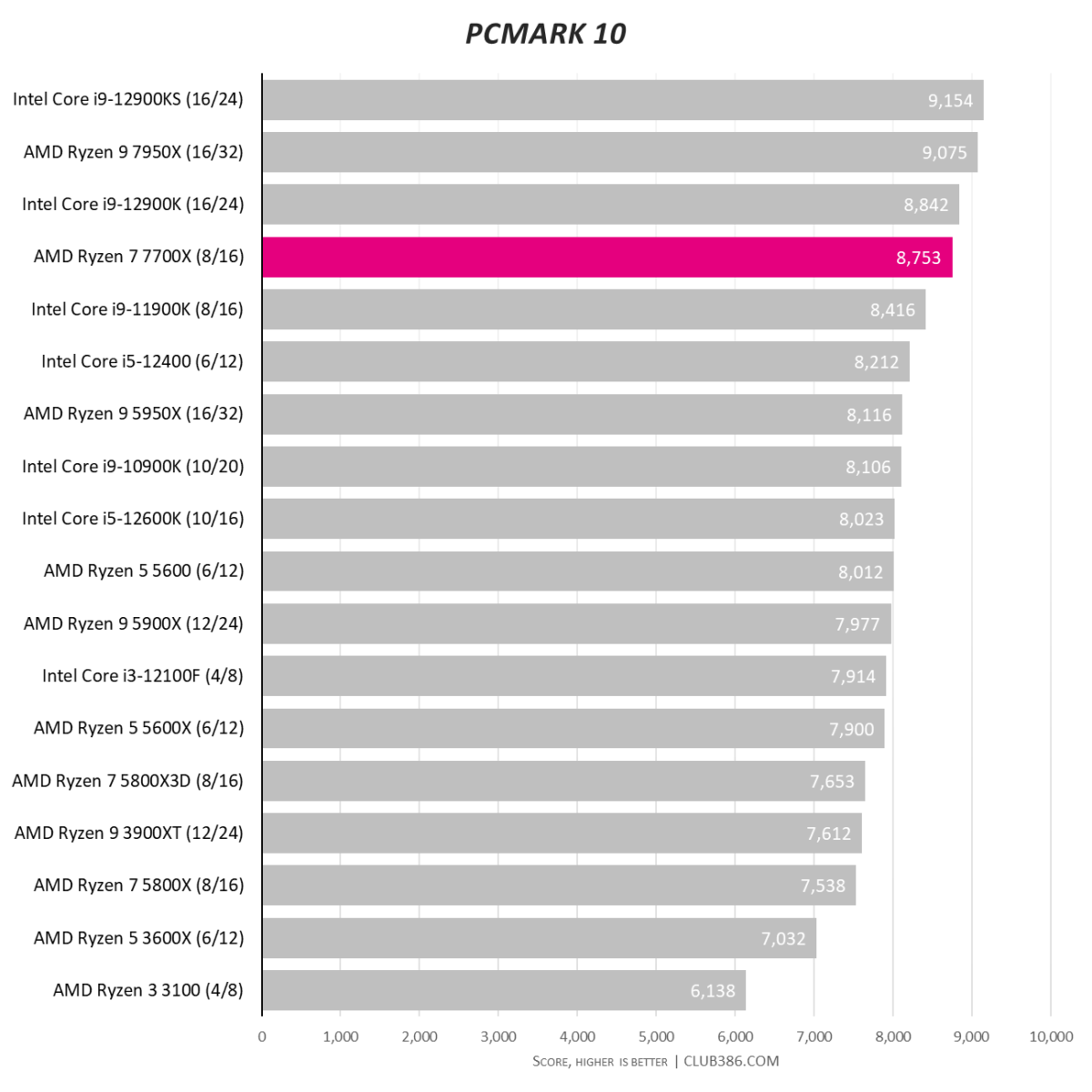
Evolutionary rather than revolutionary, Ryzen 7 7700X improves on an already-potent eight-core configuration.
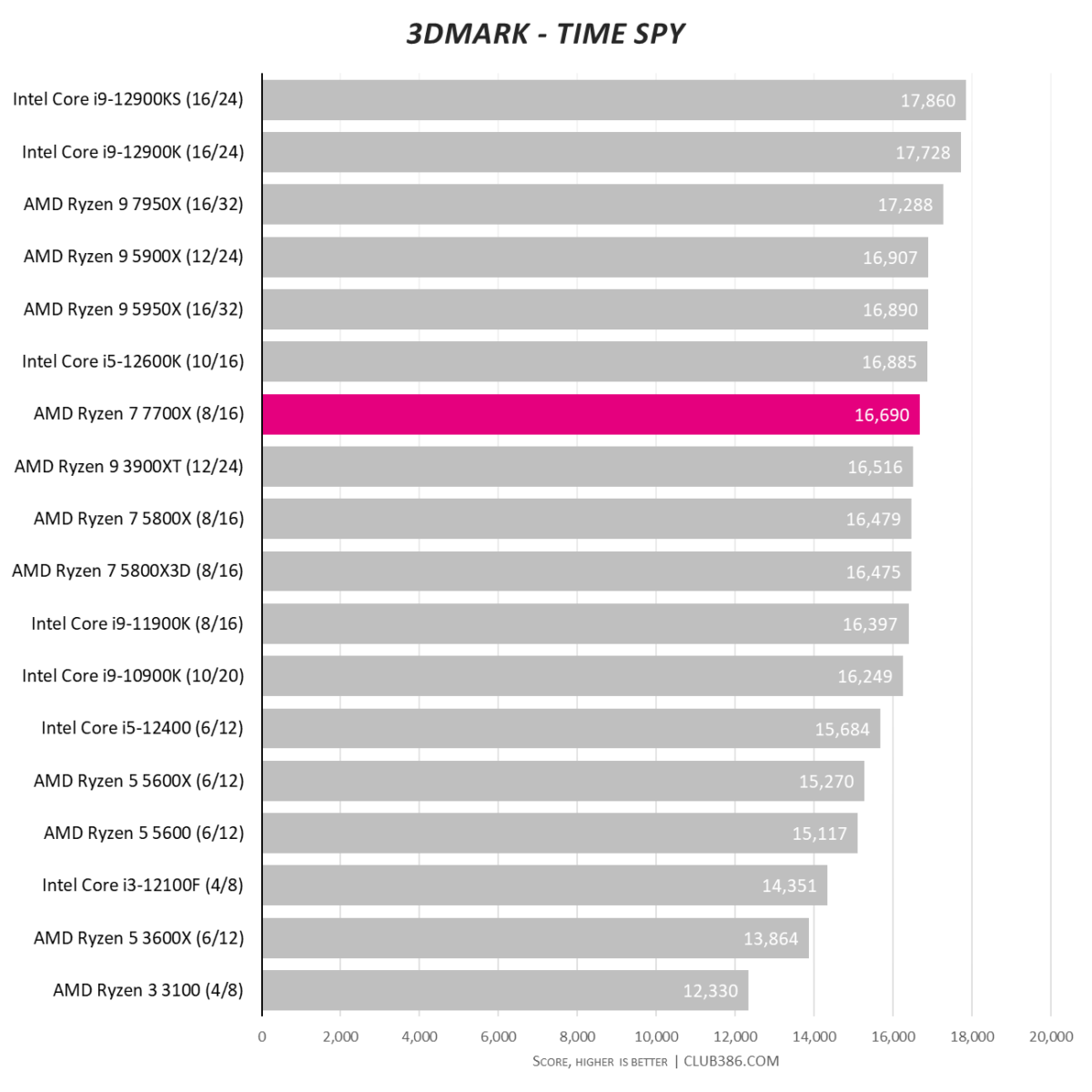
Gamers are, without doubt, a key audience, and Ryzen 7 7700X puts up a solid if not spectacular showing in synthetic 3DMark.
Gaming
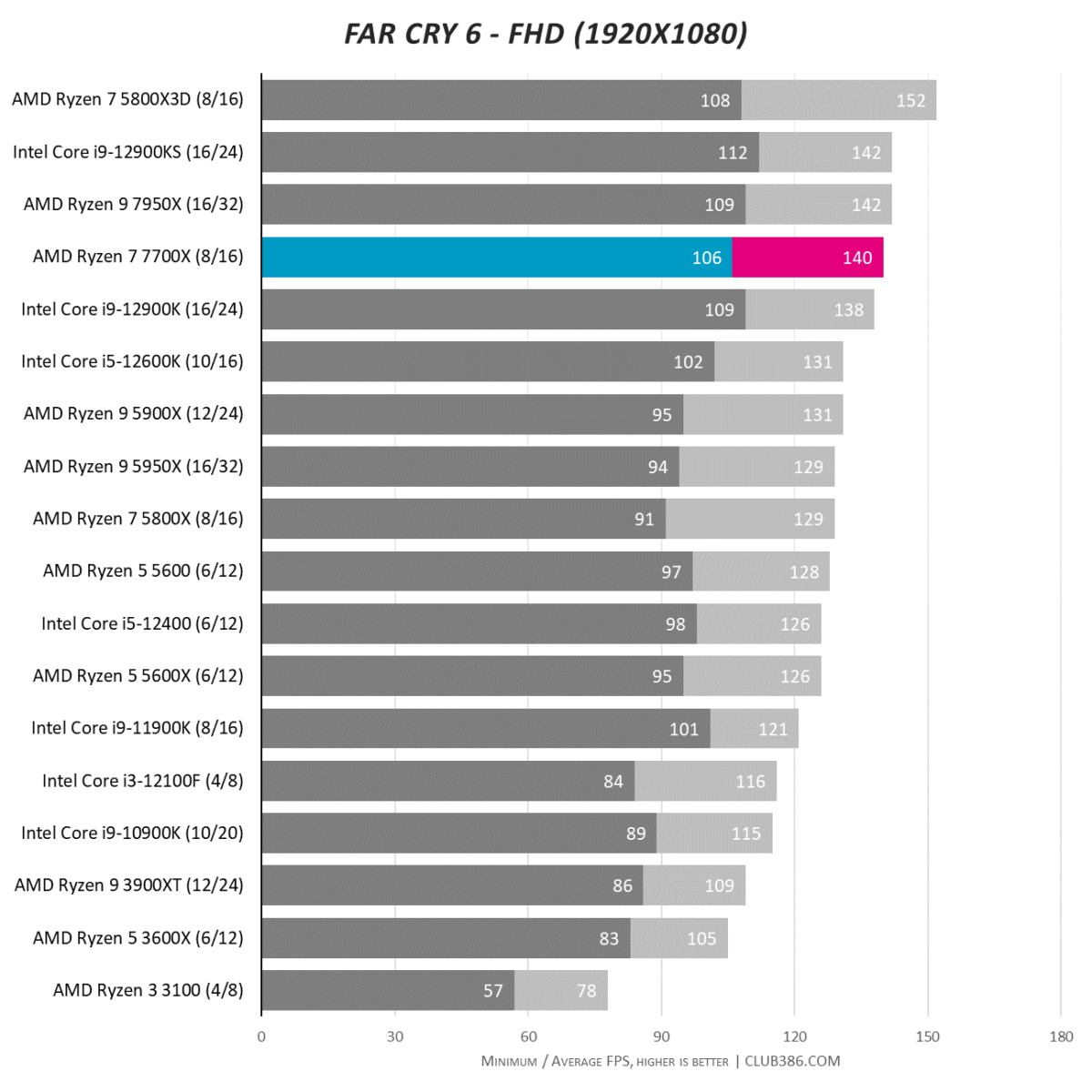
Real games often paint a more accurate picture. Far Cry 6 clearly enjoys the Zen 4 architecture and extra frequency headroom. Even the 12-core Ryzen 9 5900X is no match for Ryzen 7 7700X here.
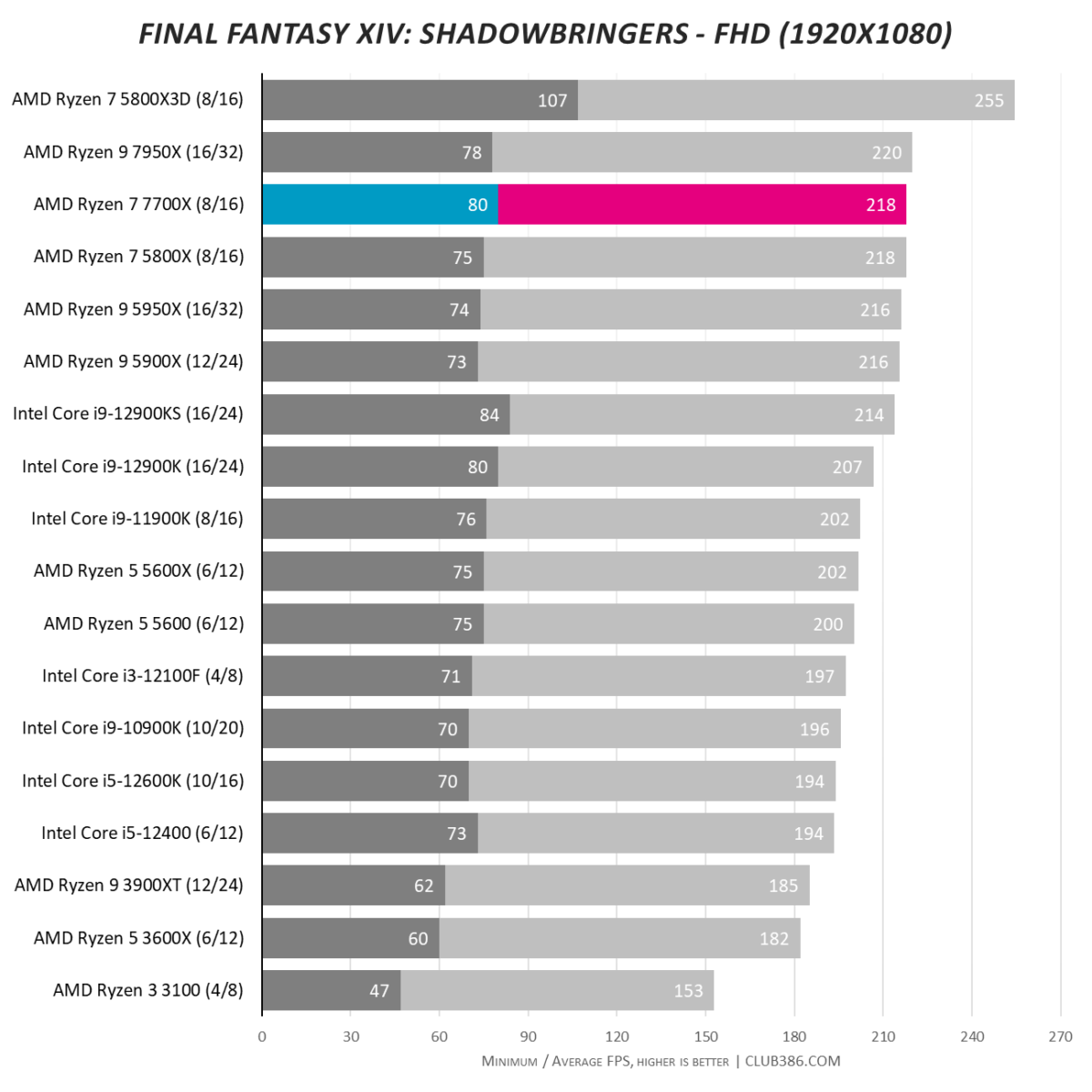
Excellent numbers again from AMD’s third-rung chip. If there’s a caveat as far as gaming is concerned, it’s that 3D V-Cache can be transformative; for enthusiasts a purported Ryzen 7 7800X3D can’t come soon enough.
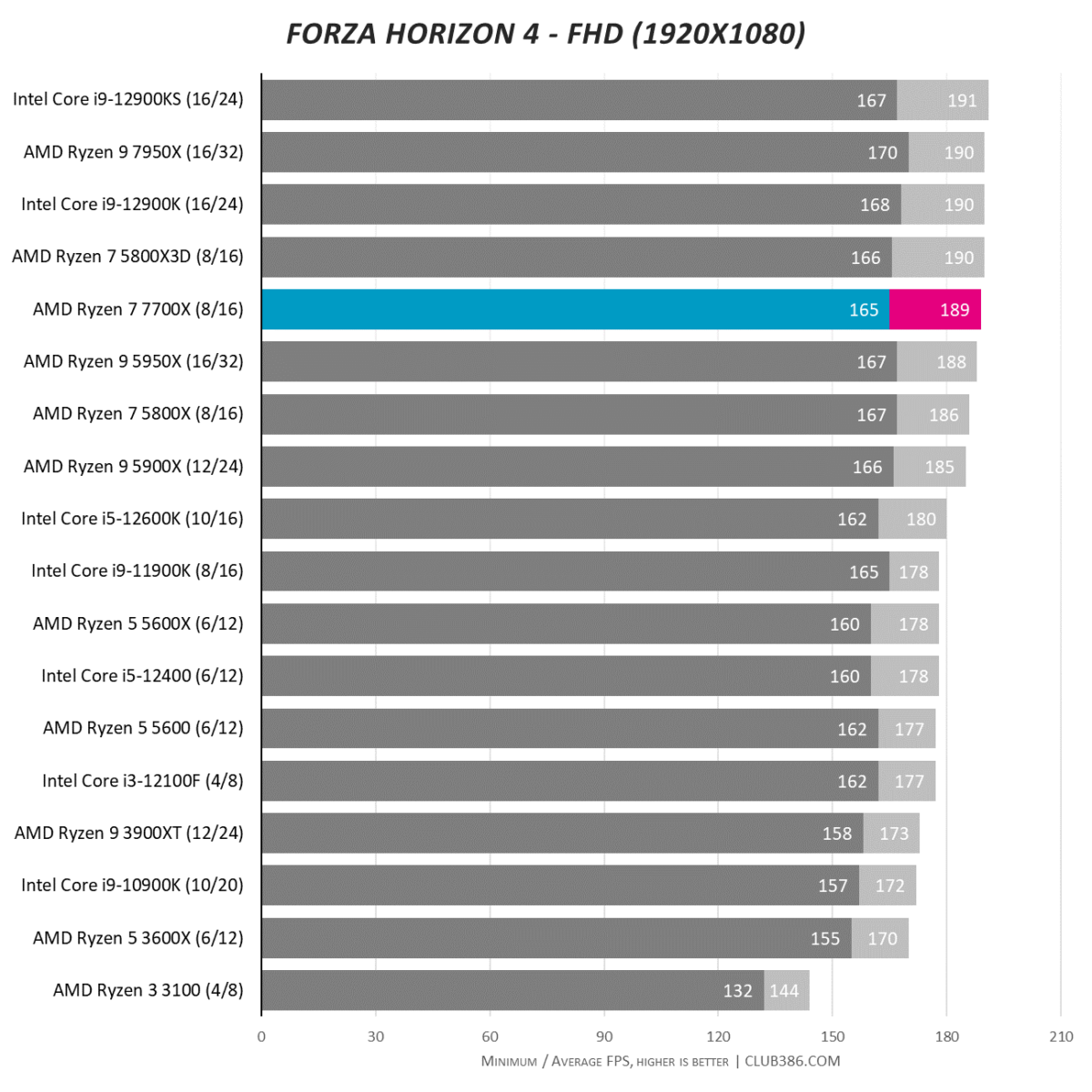
The days of Ryzen being deemed inferior for gaming are long gone. 7700X is a fine fit for any modern-day rig.
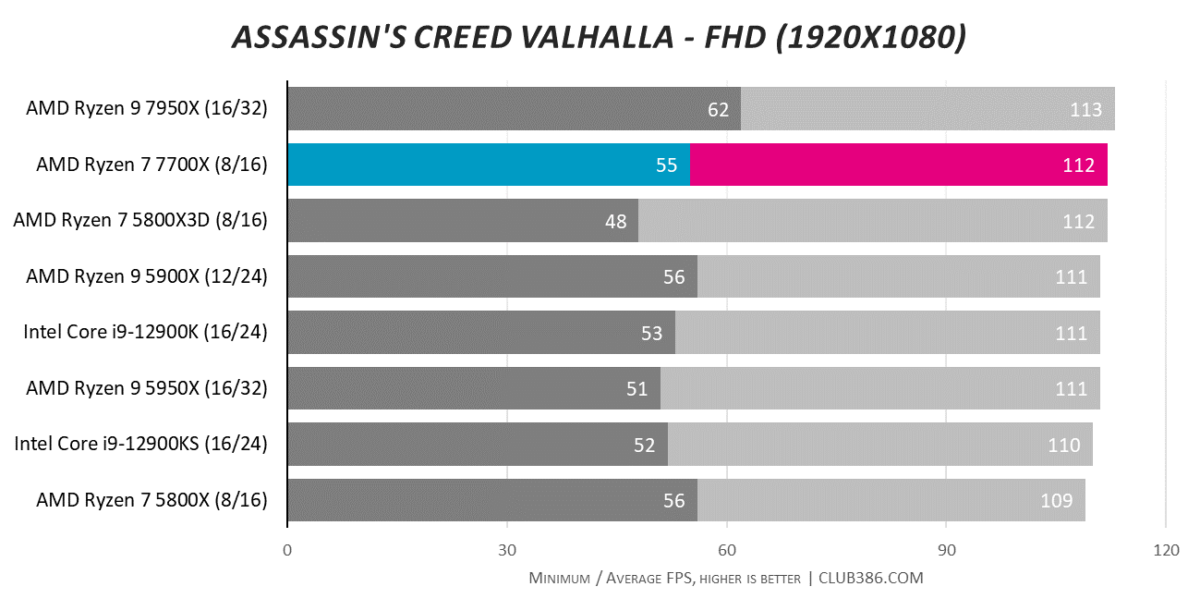
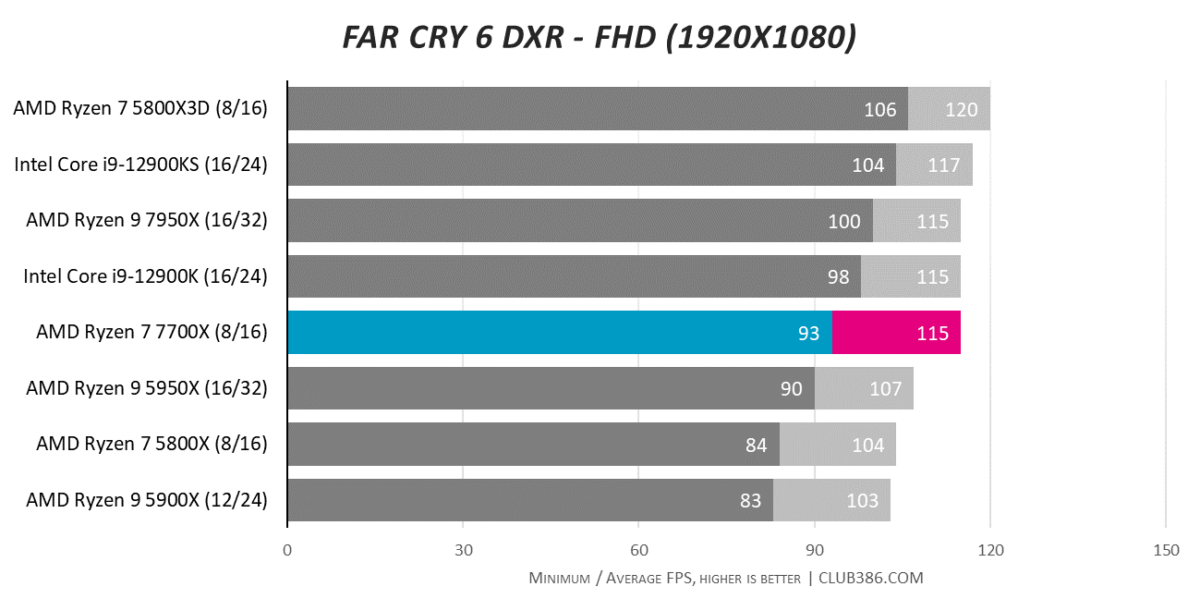
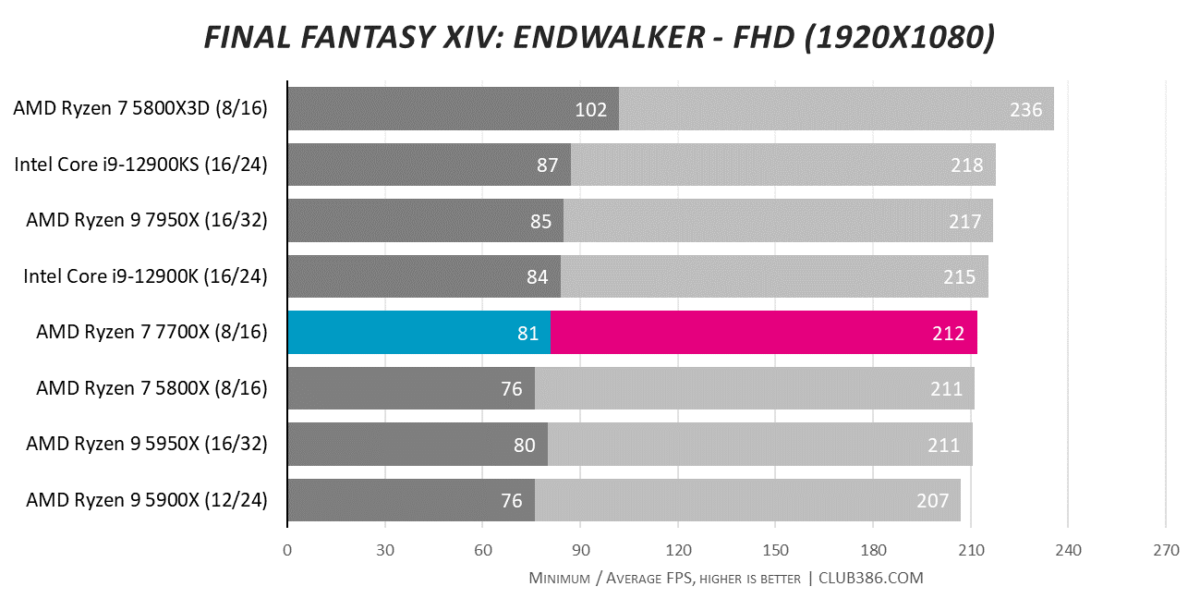
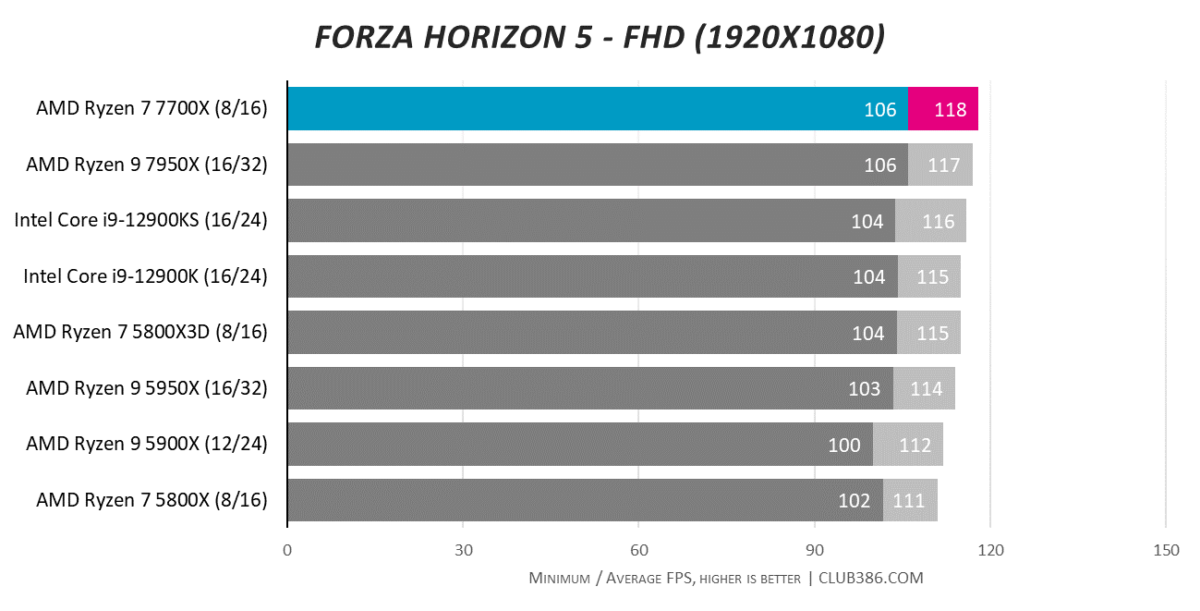
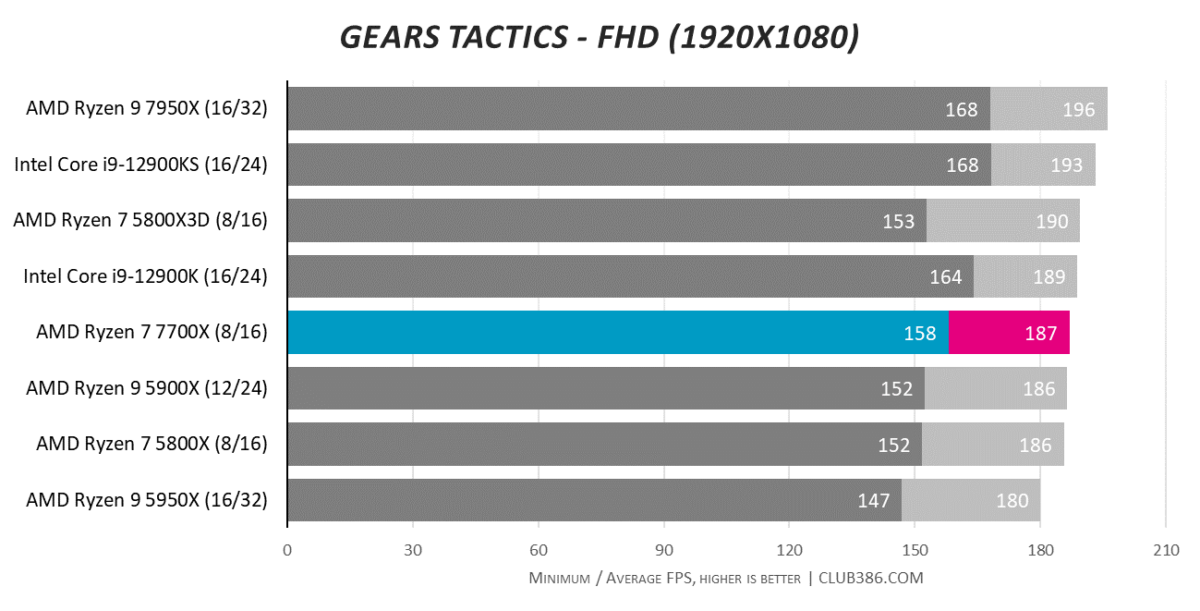
Honing-in on seven of the very best CPUs reveals very little in it with regards to high framerates at 1080p when playing with ultra-high-quality settings. The gap would of course shrink at higher resolutions, where the onus shifts largely to GPU, and though 5800X3D occasionally serves as a potent outlier, all of these chips are well attuned to gaming.
Efficiency and Value
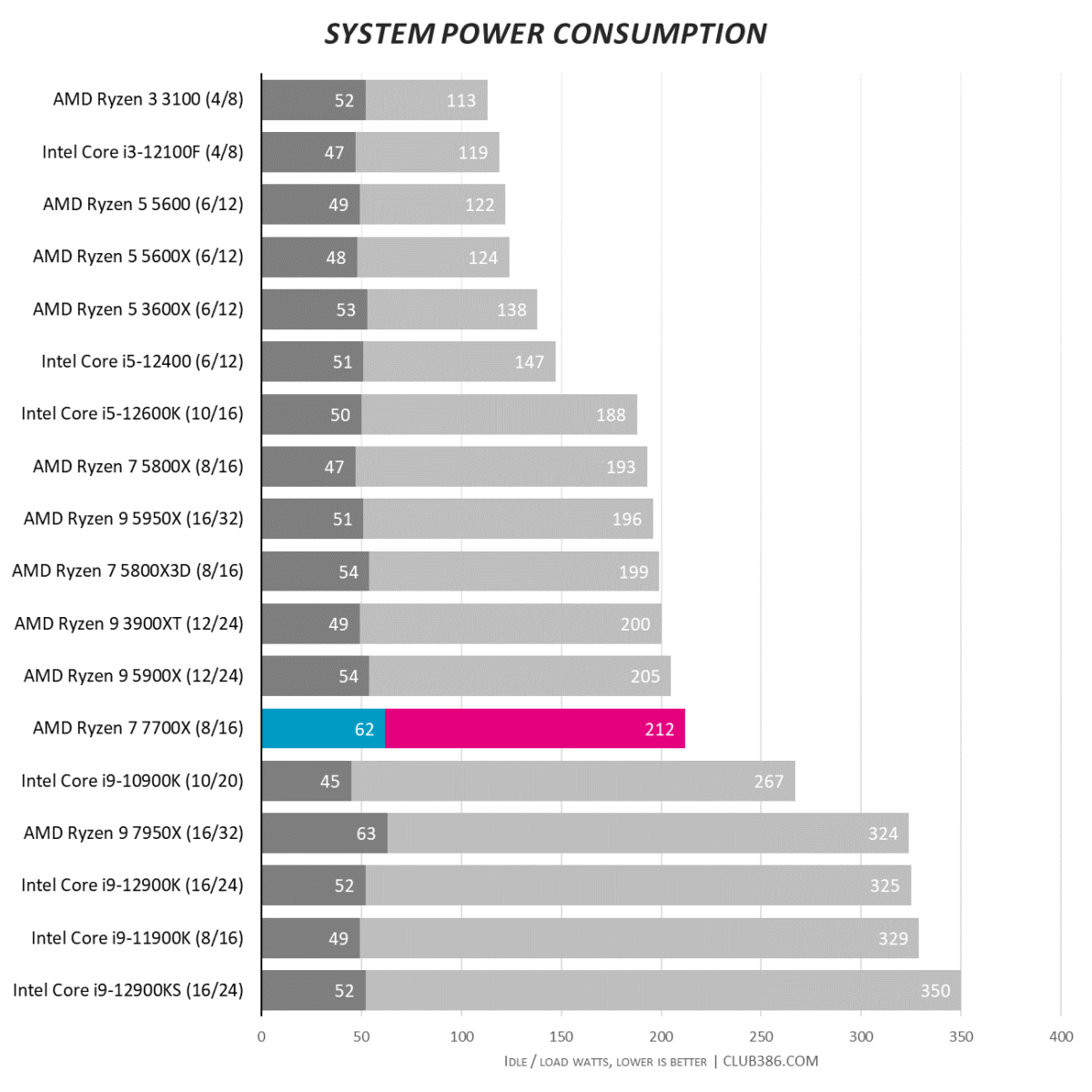
Whereas top-of-the-line Ryzen 9 7950X raises system-wide power consumption significantly, the 105W Ryzen 7 7700X is a more familiar beast. Keeping close to the ~200W mark makes a whole lot of sense in the midst of today’s energy crisis.
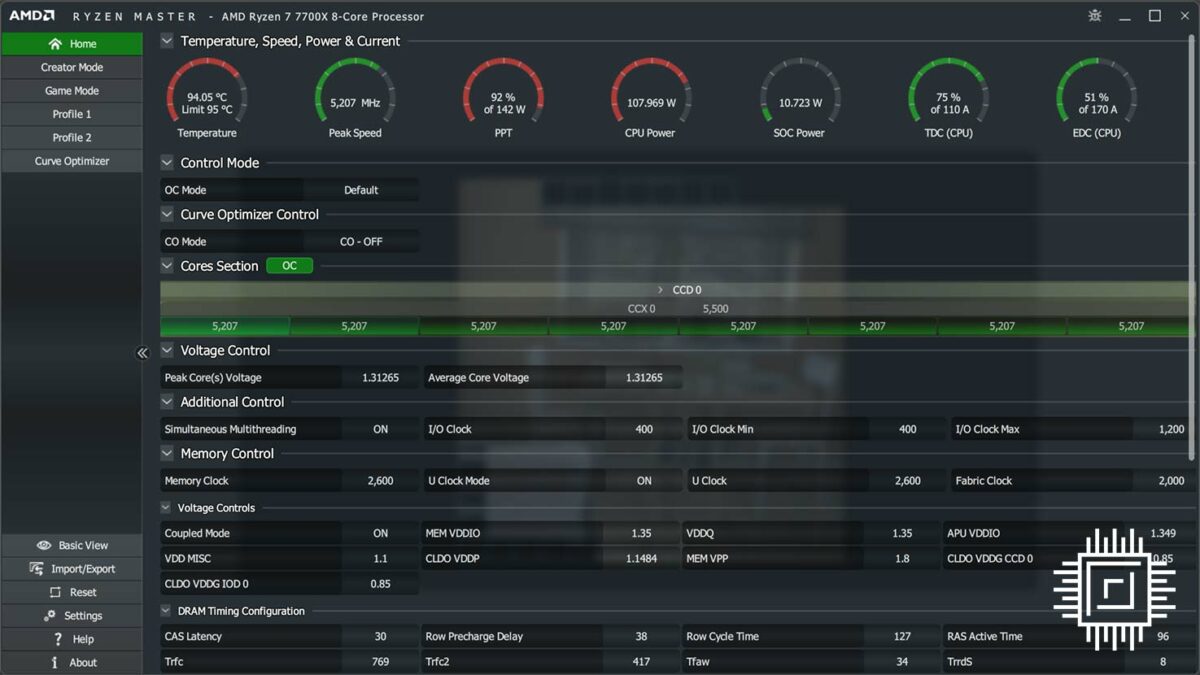
Lofty frequencies naturally translate to hot-running chips, yet the expectation is for high-end Ryzen 7000 Series CPUs to sit at or around a maximum thermal junction temperature (TJMax) of 95°C under full load.
AMD describes this as a “safe operating temperature,” adding that Ryzen 7000 processors are “designed to run at TJMax 24/7 without risk of damage or deterioration.” That may well be true – we haven’t experienced any thermal throttling or instability in our weeks of testing – yet it goes without saying, you’ll want a capable cooler to help disperse heat output efficiently.
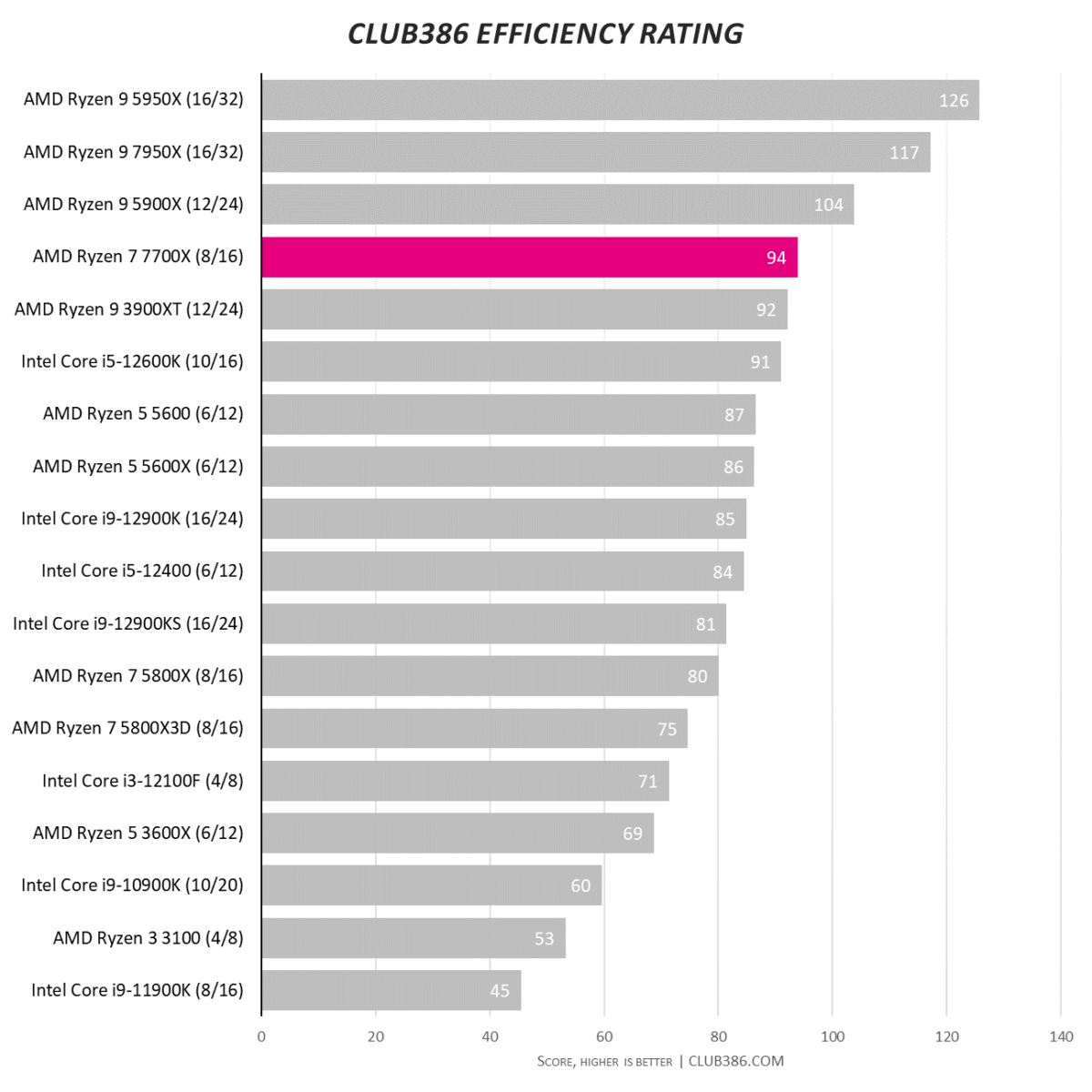
Speaking of efficiency, it’s always fun to divide each CPU’s multi-core Cinebench result by system-wide power recorded during the same test. Ryzen 7 7700X is found to be 17.5 per cent more efficient than Ryzen 7 5800X in this scenario.
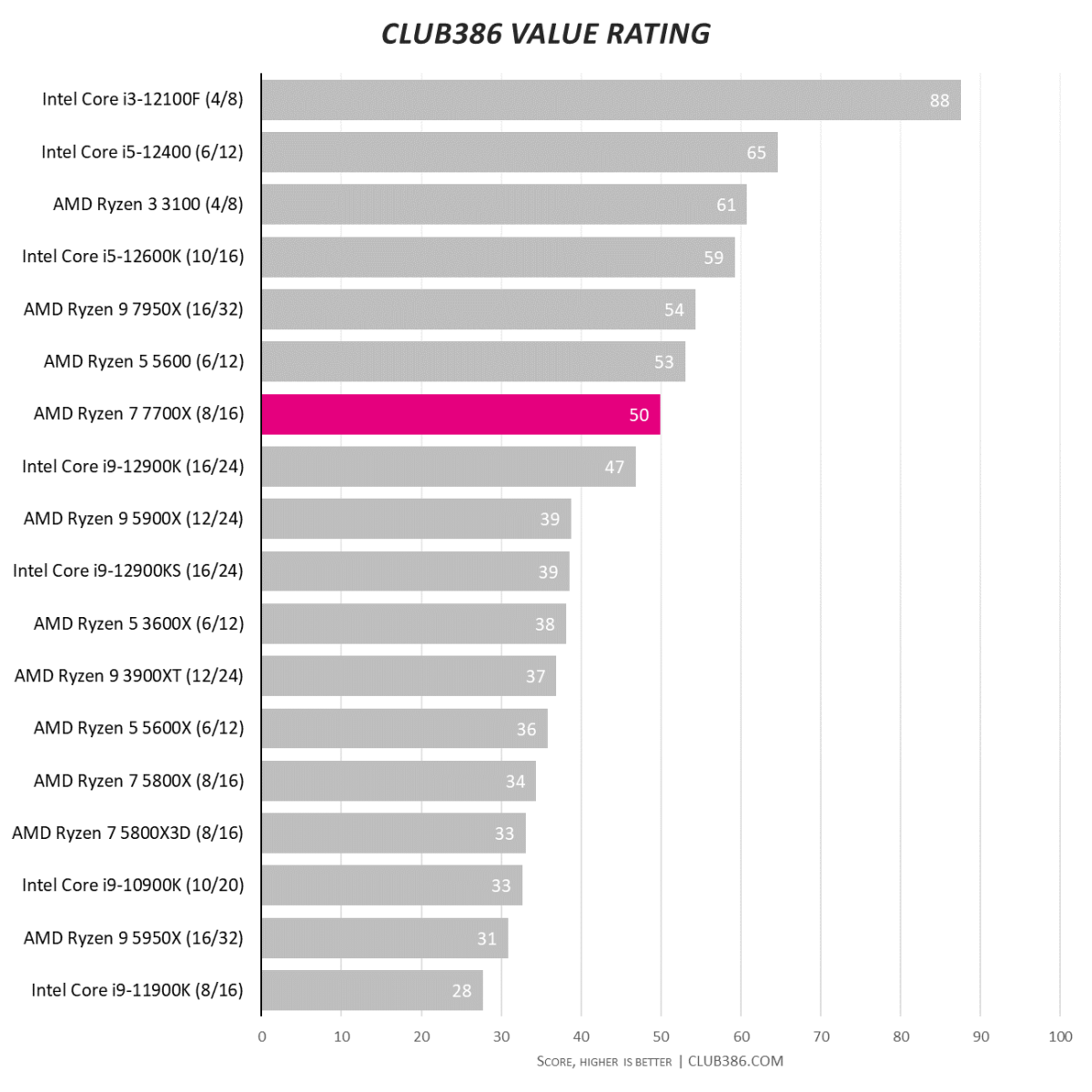
Evaluating retail value in today’s volatile markets is much easier said than done. CPU prices can fluctuate wildly from one day to the next, and from one region to another. In an effort to maintain consistency, our value rating divides the Cinebench multi-core result by each CPU’s launch MSRP.
7700X is not only comfortably quicker than outgoing 5800X, it also arrives carrying a lower $399 price tag. Discounts on current 5000 Series chips serve to disrupt the established order – Ryzen 7 5800X on sale at £260 here on UK shores represents good value – however such offers are disappearing fast.
Conclusion
Ryzen 7000 marks the beginning of AMD’s AM5 era in composed fashion, with significant performance boosts and an arsenal of supporting chipsets designed to stave-off the looming Intel 13th Gen threat.
From a purely benchmark perspective, heightened frequencies and broadened power limits allow Zen 4 chips to stretch their legs, but of course there’s much more to it than that. AM5 brings with it feature-packed motherboards, mandatory support for DDR5, PCIe 5.0, and desktop CPUs that all pack modest onboard graphics as standard.
Key upgrades across the board yet given the inherent complexities of a whole-new socket, AMD has played it largely safe in terms of architecture. Zen 4 has the feel of a mature design refined to the nth degree, and we’ll have to wait until 2024’s Zen 5 for a complete ground-up redesign.
The good news is that AM5 is built to last, and if AMD’s recent commitment to socket longevity is anything go by, we suspect motherboards purchased in late 2022 will allow upgrades for at least another generation or two.
Returning to the launch-day Zen 4 quartet, mid-pack Ryzen 7 7700X adopts a familiar eight-core, 16-thread format but delivers a sizeable uptick in frequency and performance-per-watt. Advantages of a newer platform are clear, and for anyone starting afresh, Ryzen 7 7700X represents an excellent choice.
Verdict: Proficient in all areas, the best eight-core, 16-thread consumer CPU to date.

